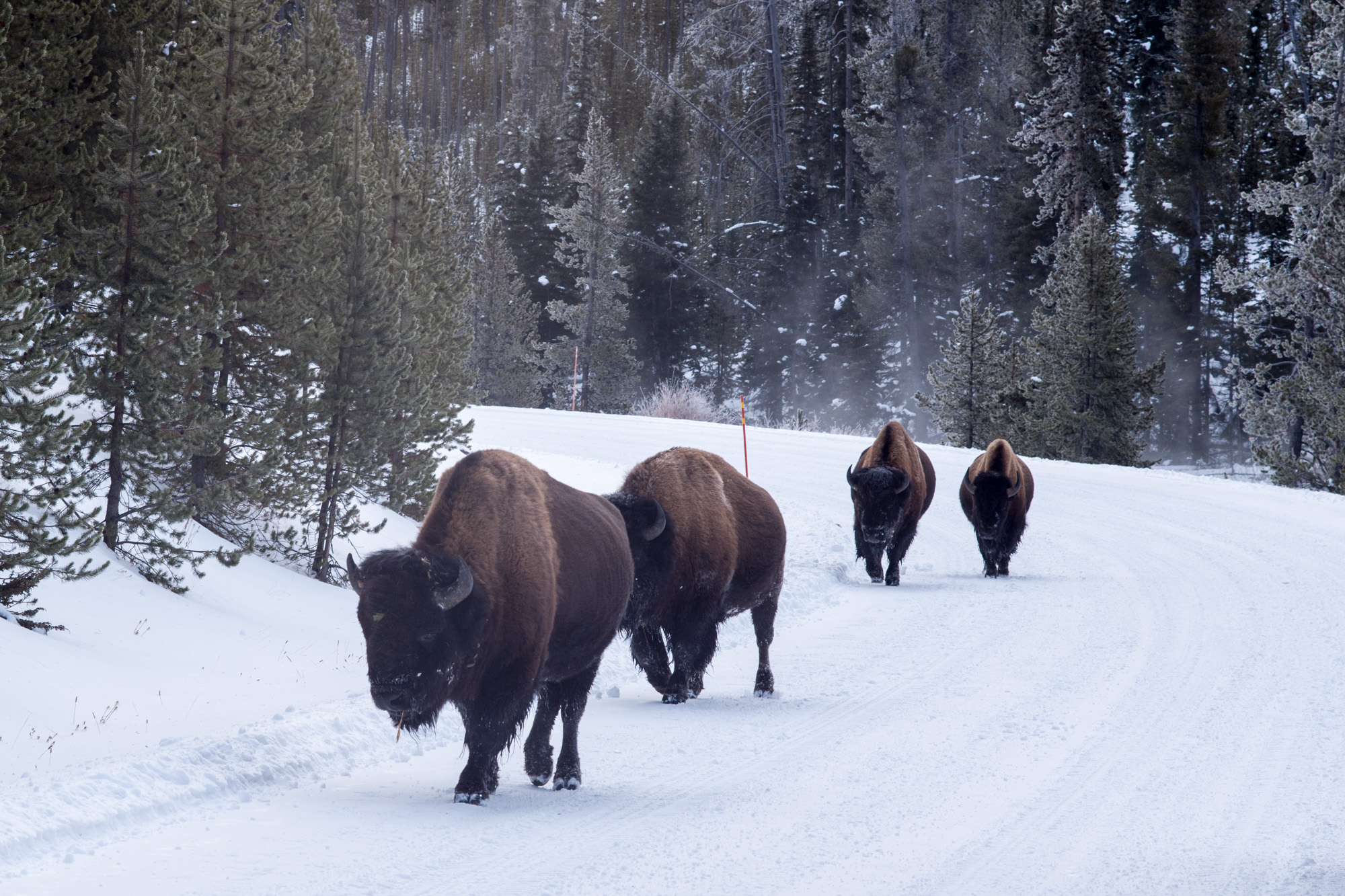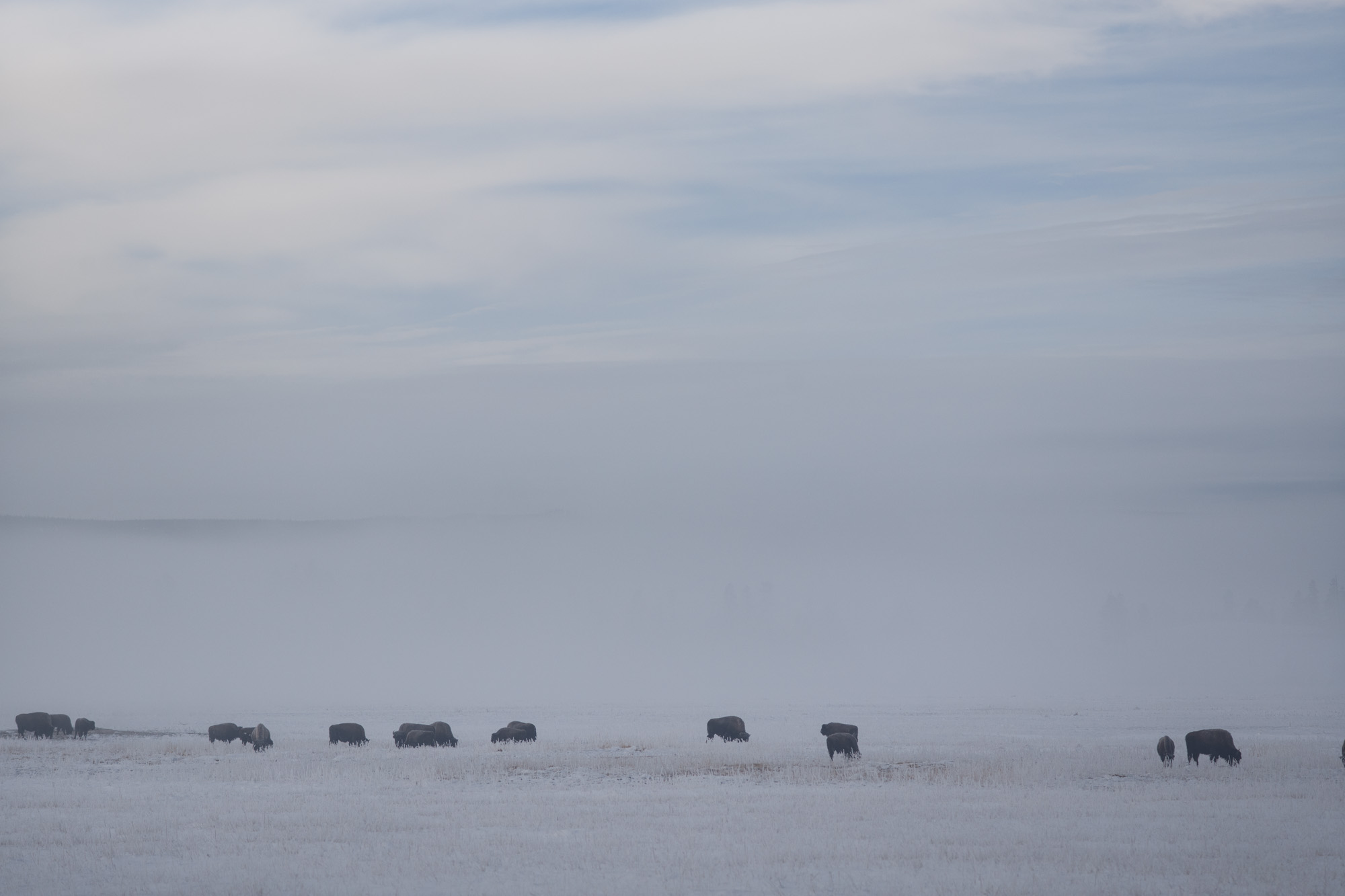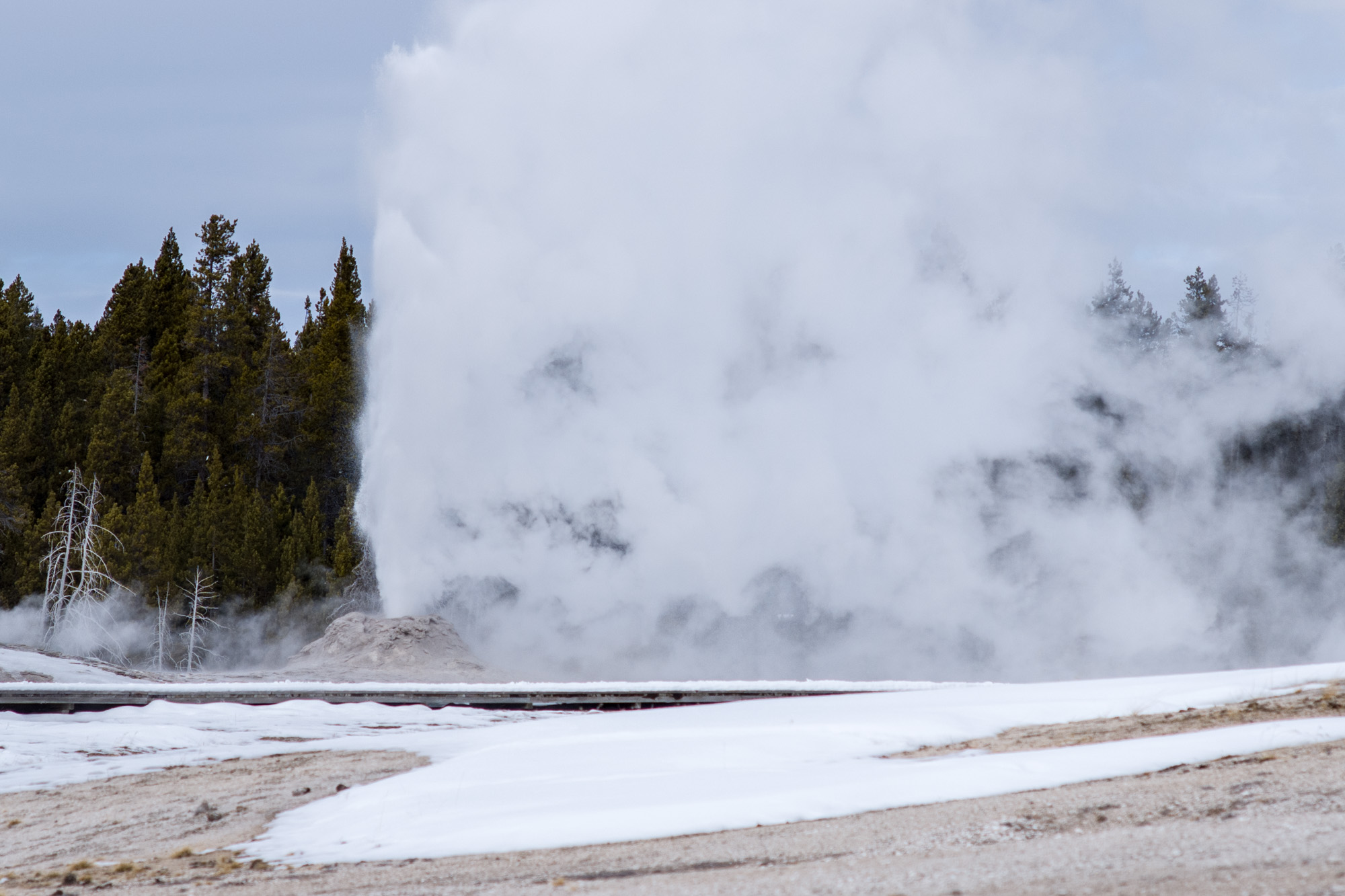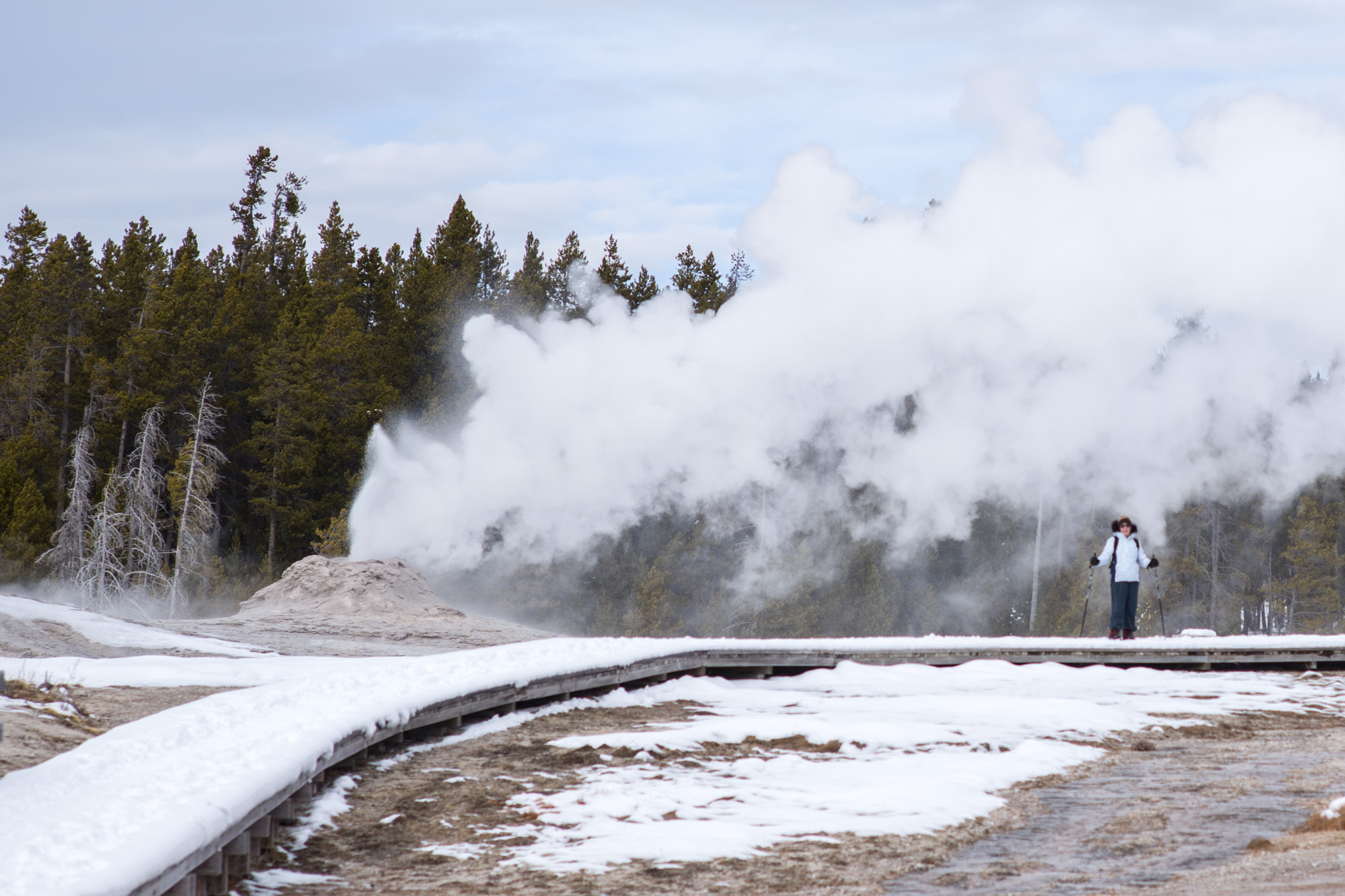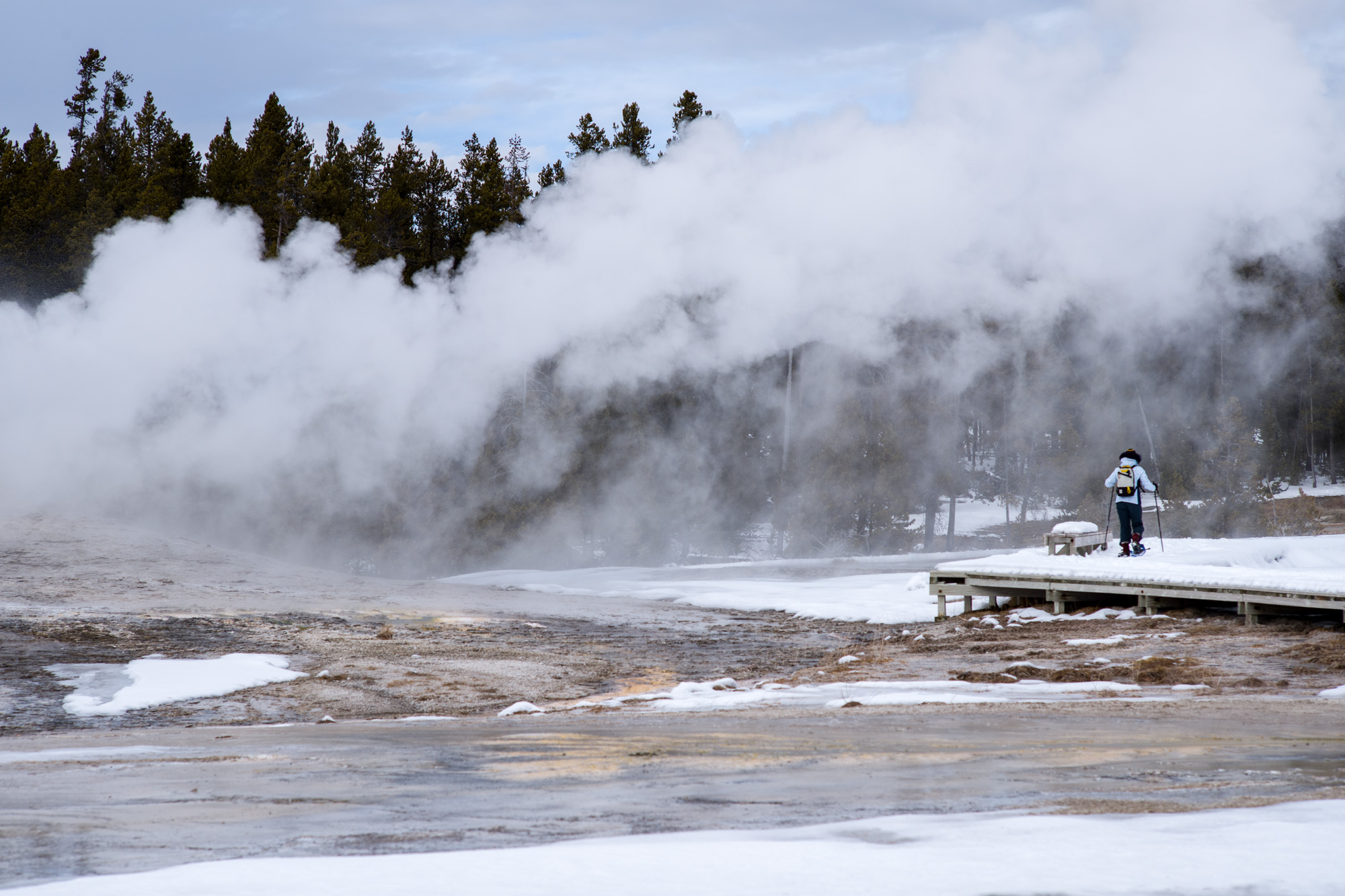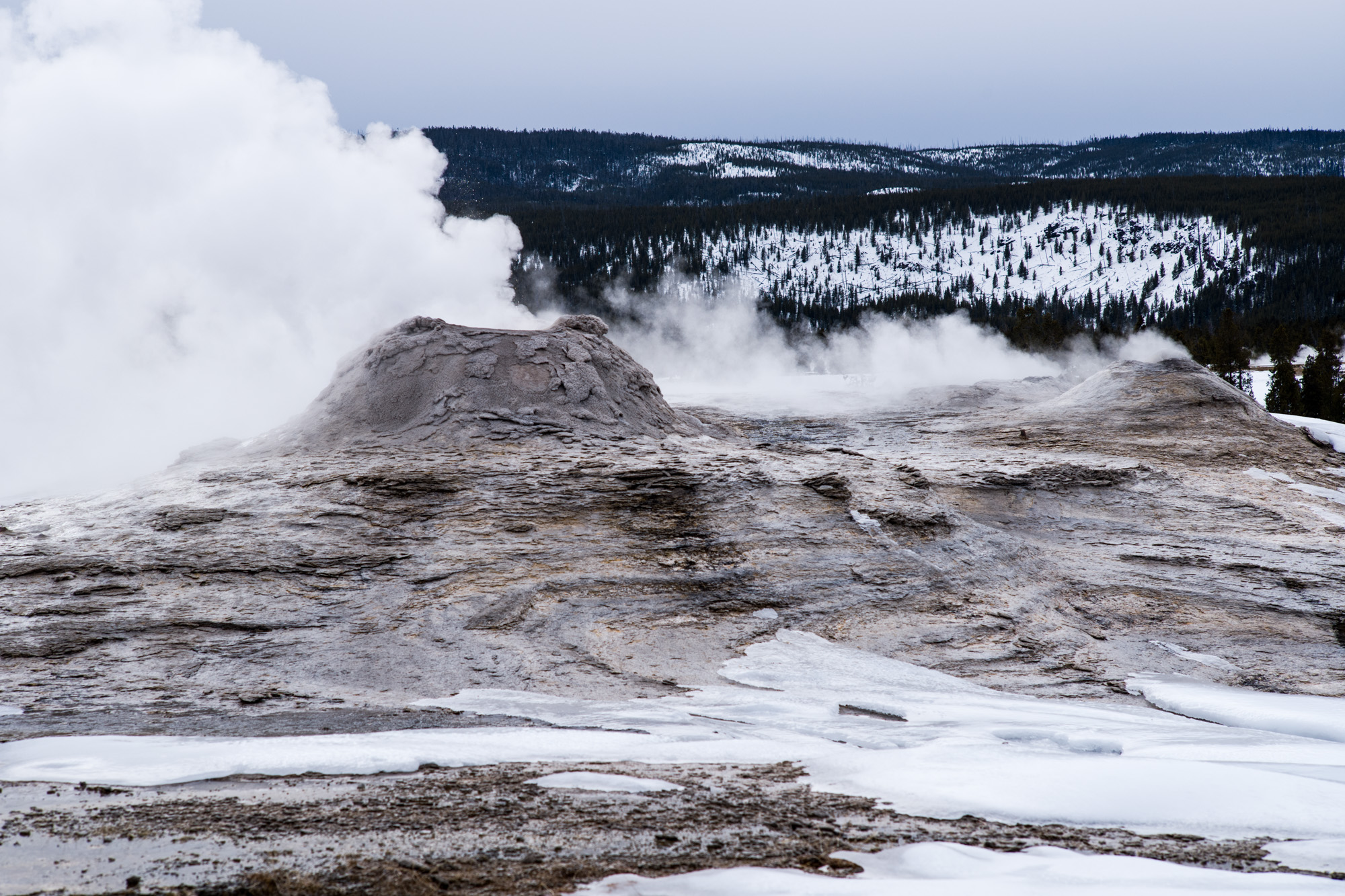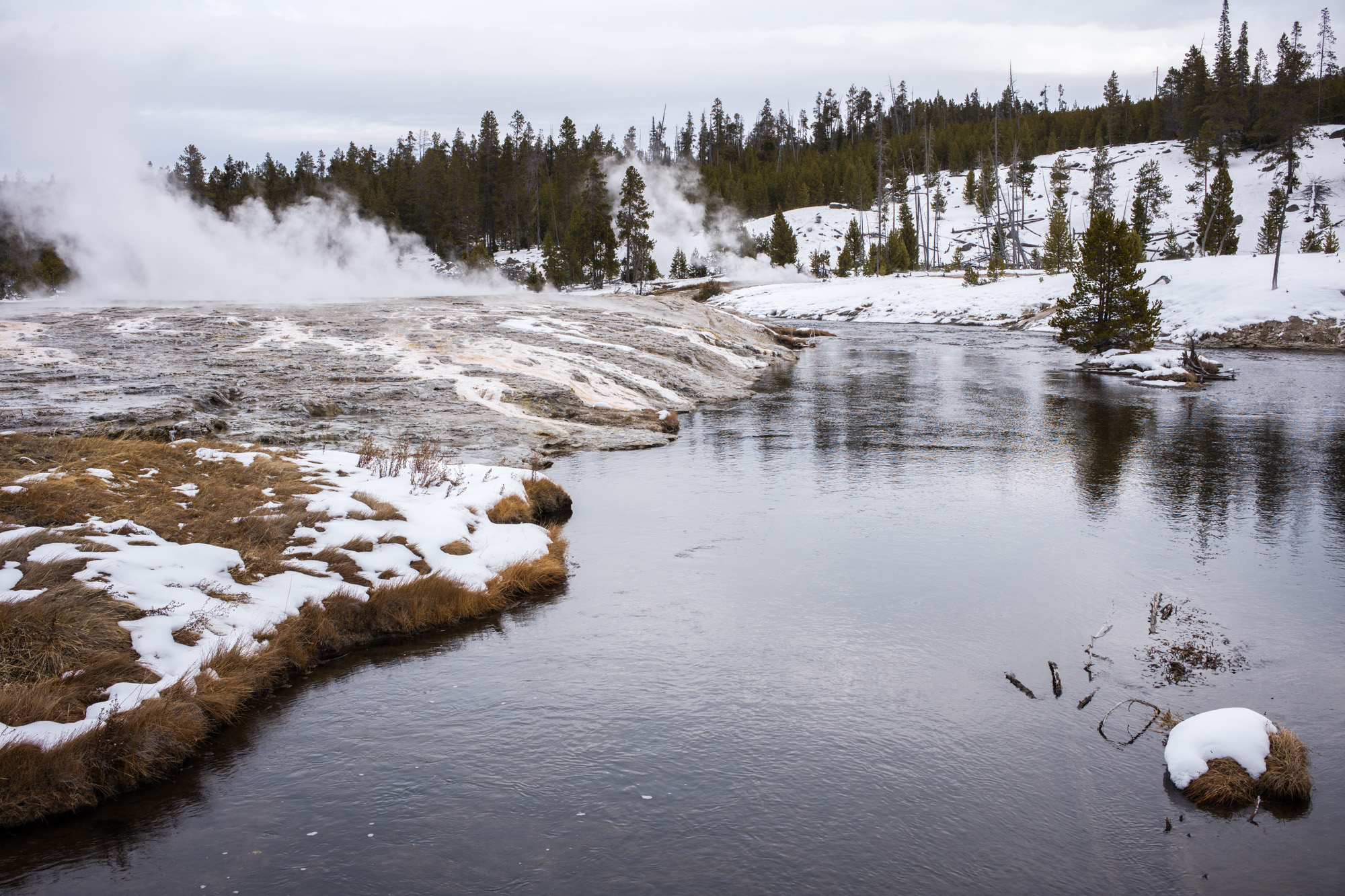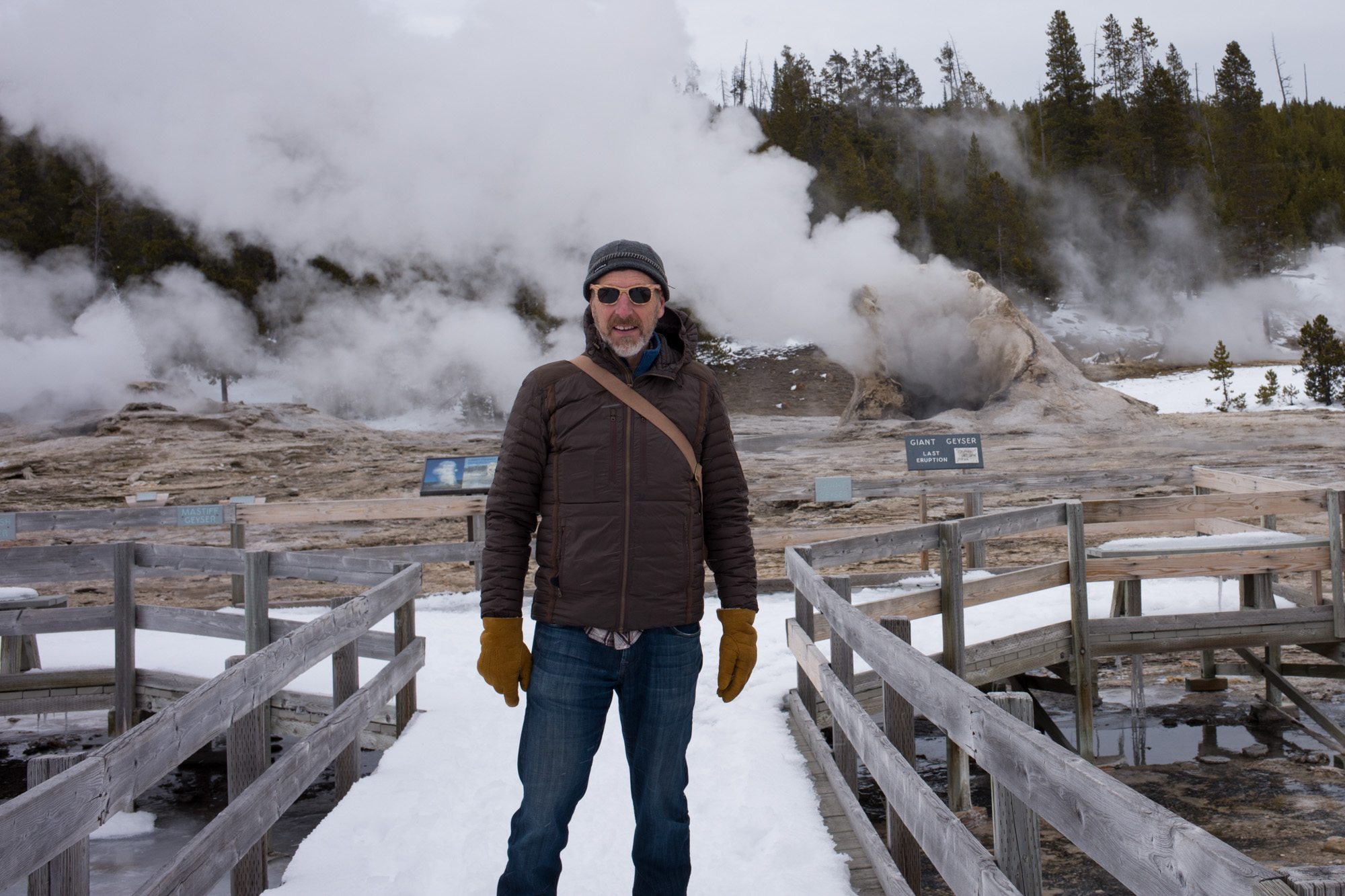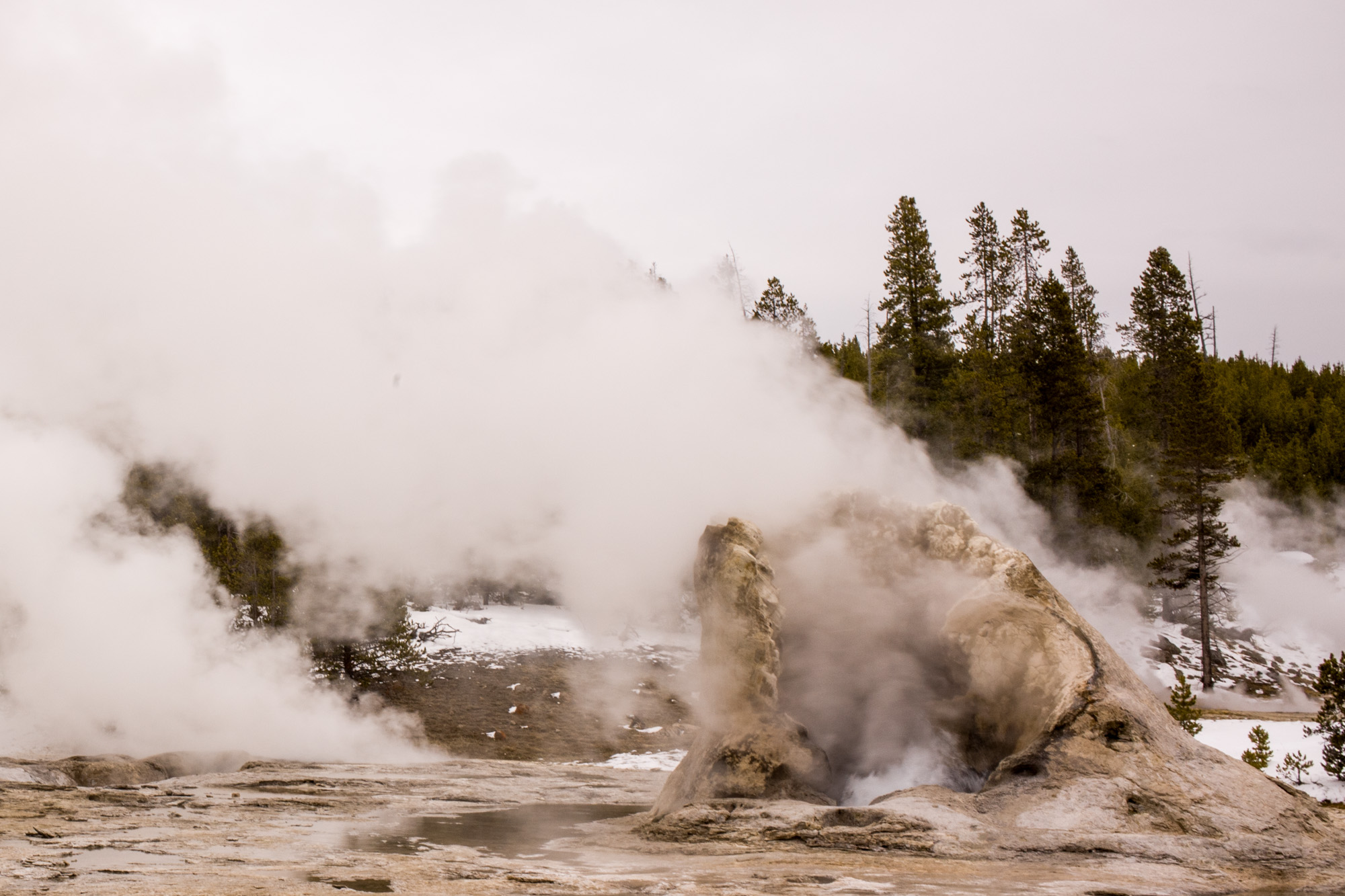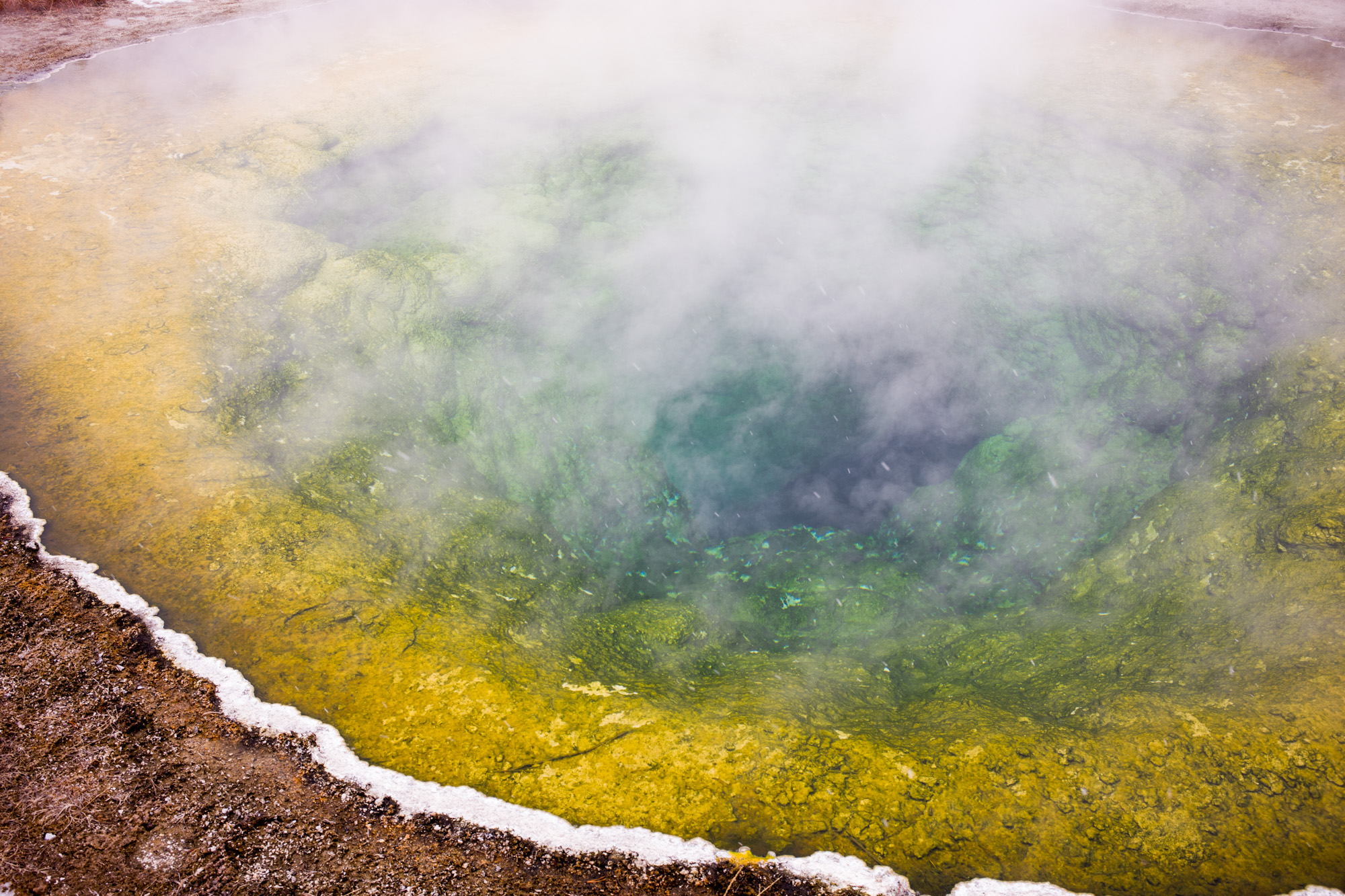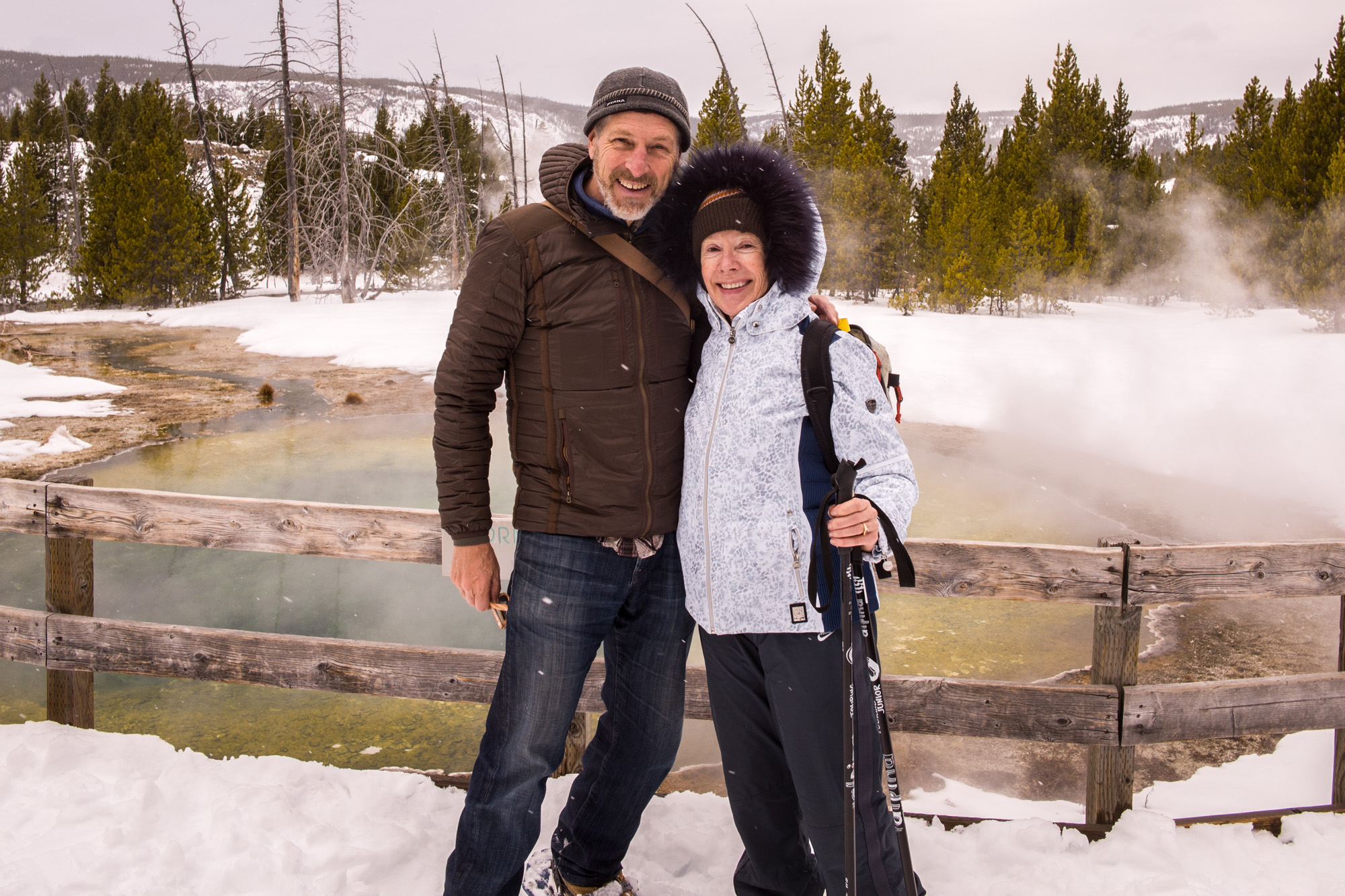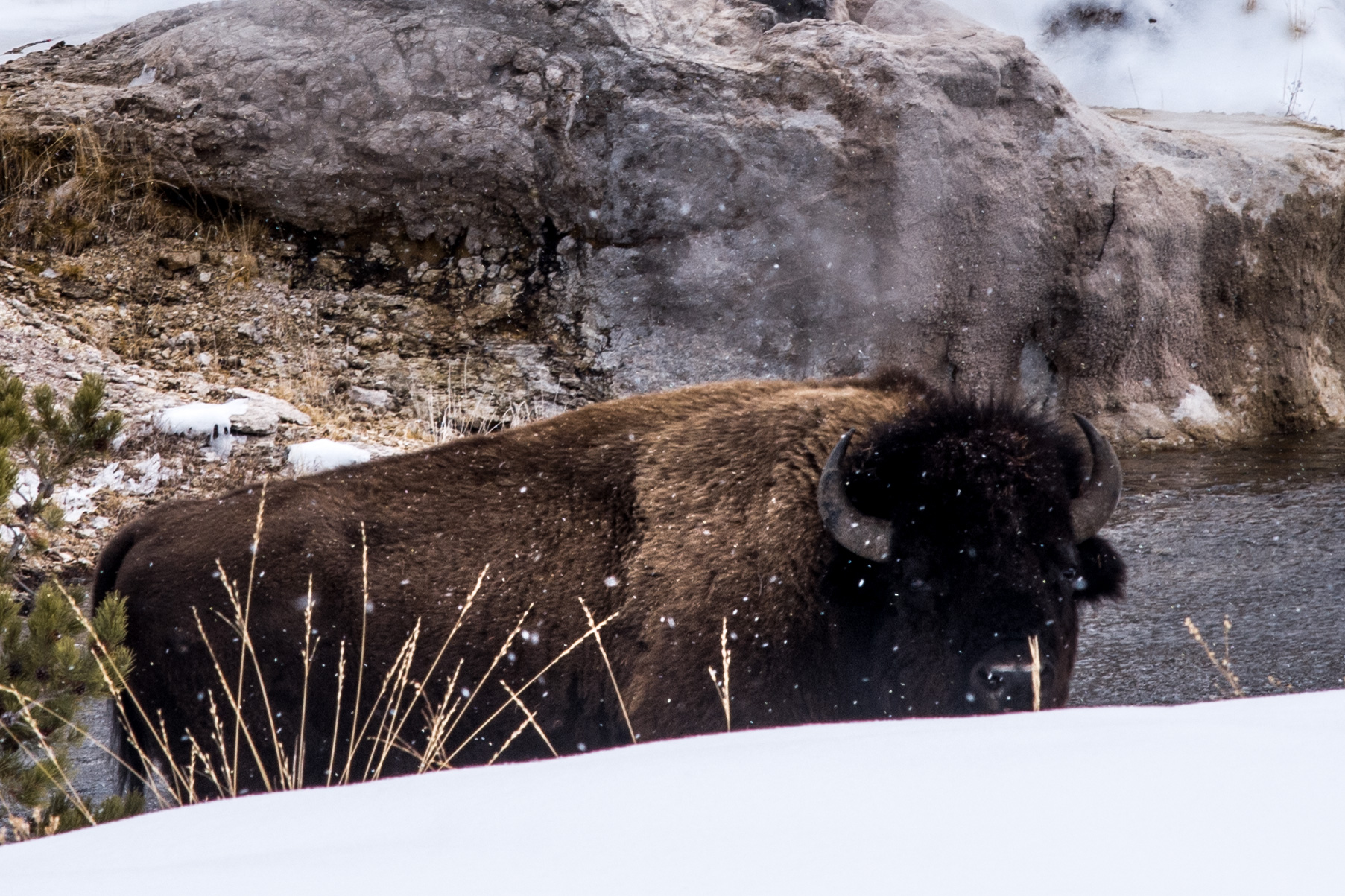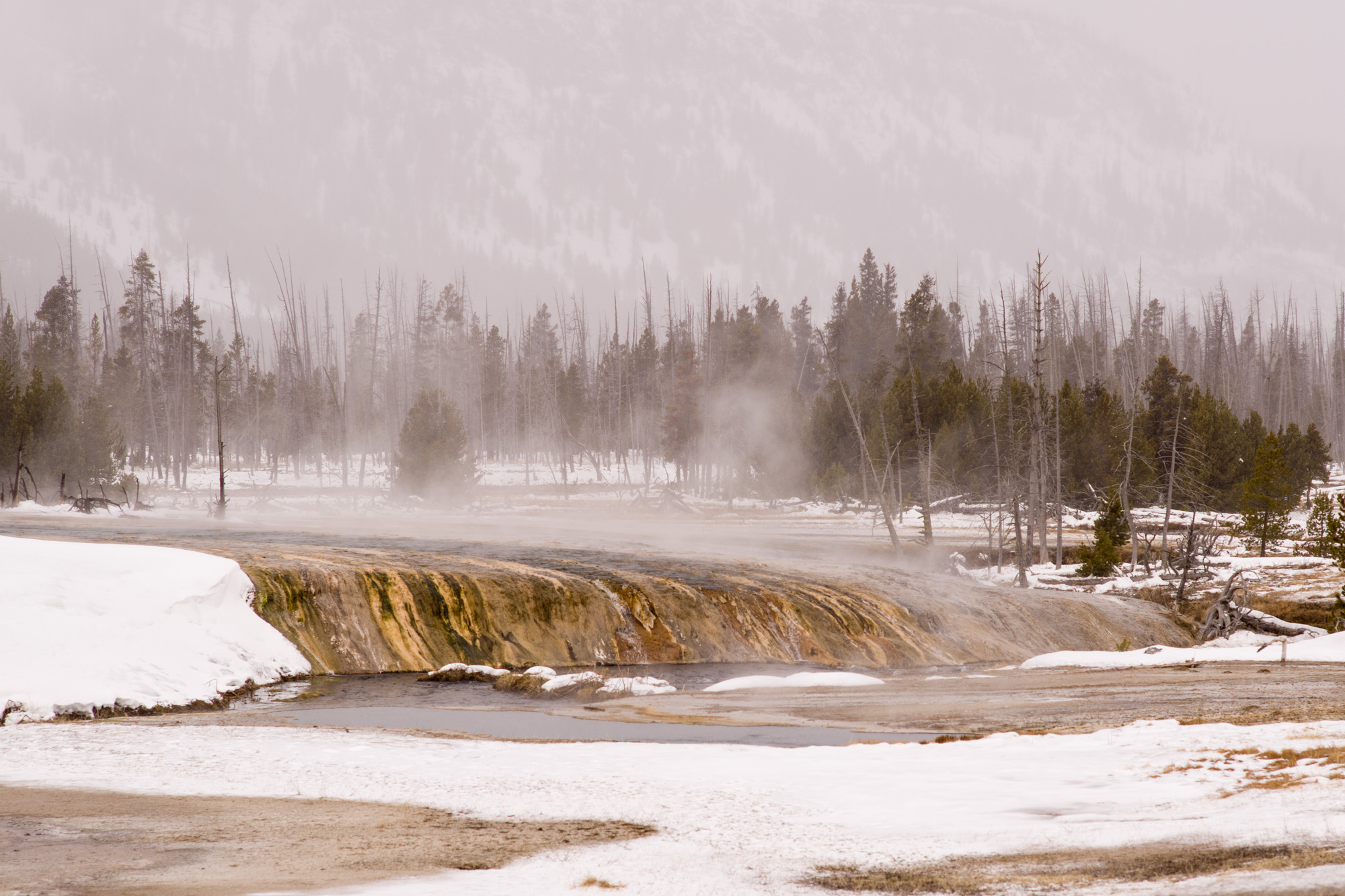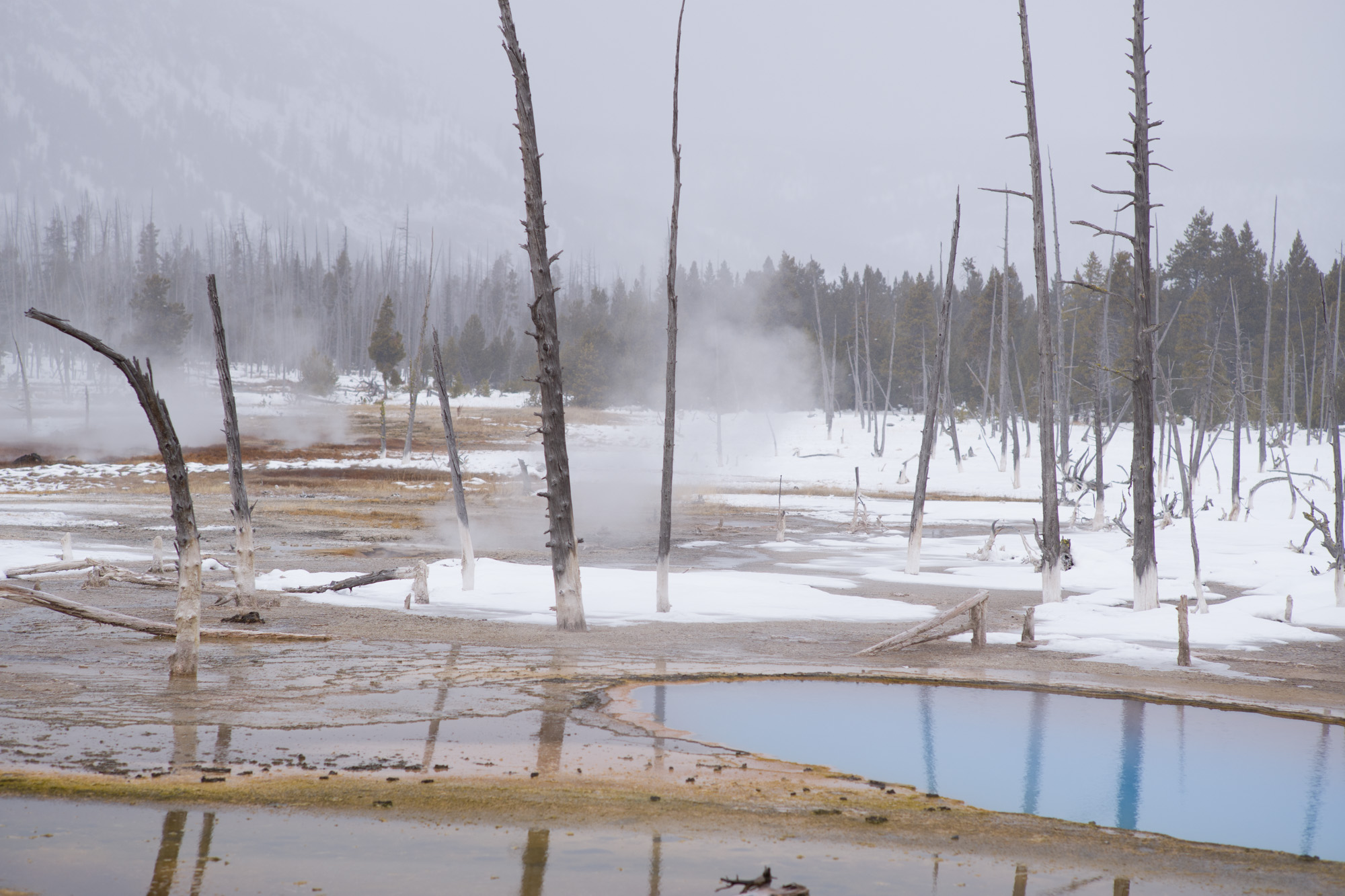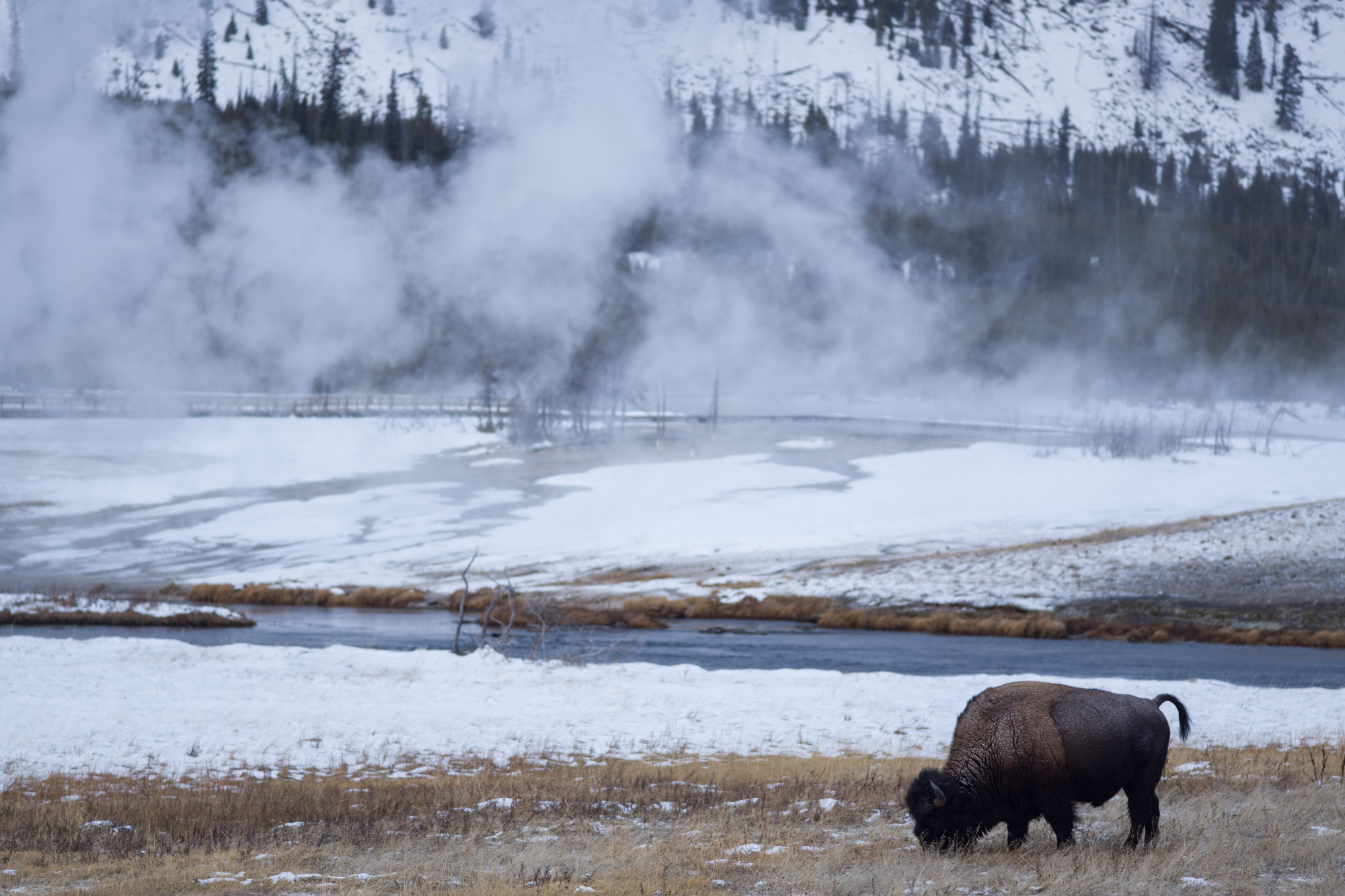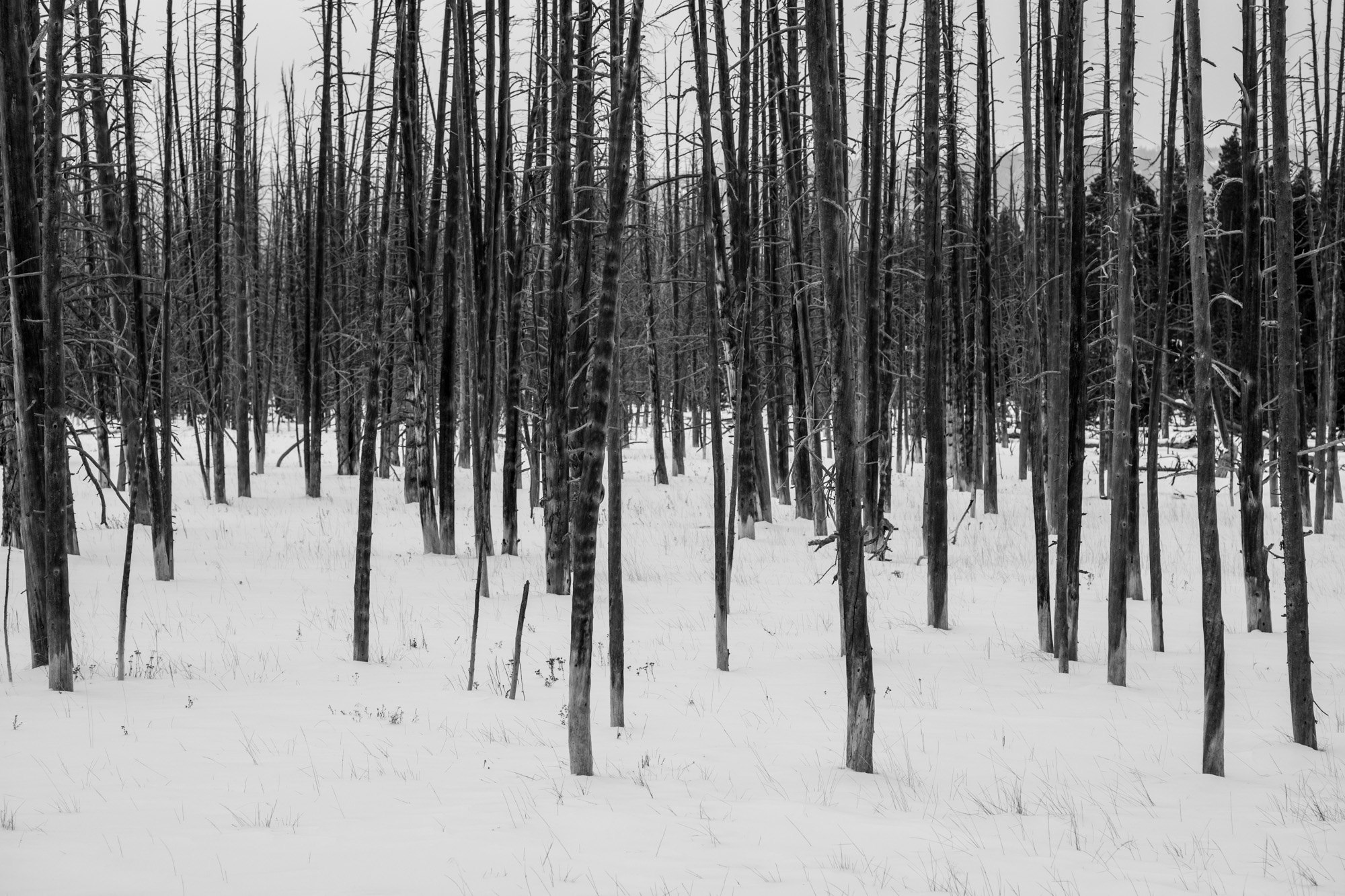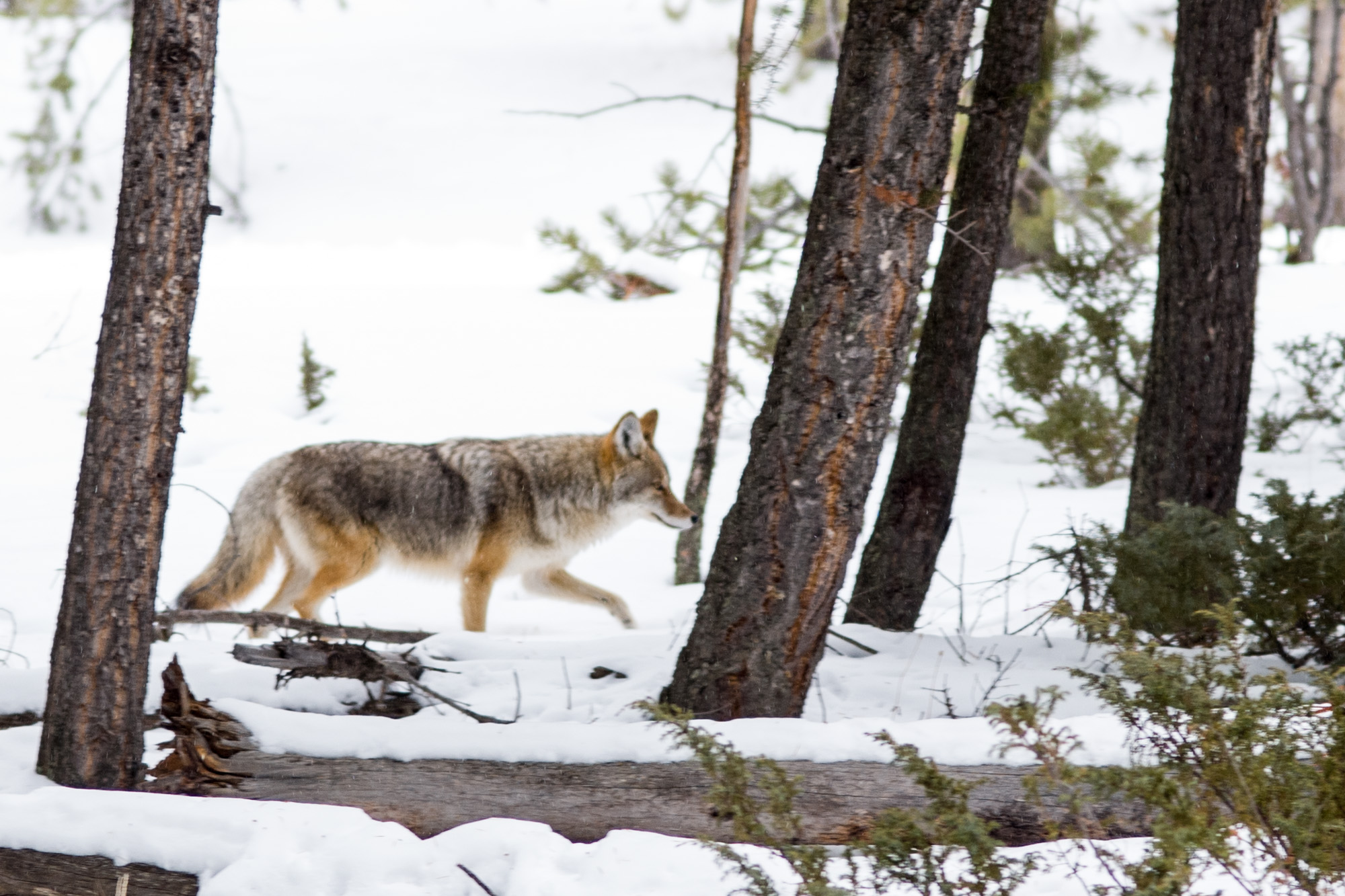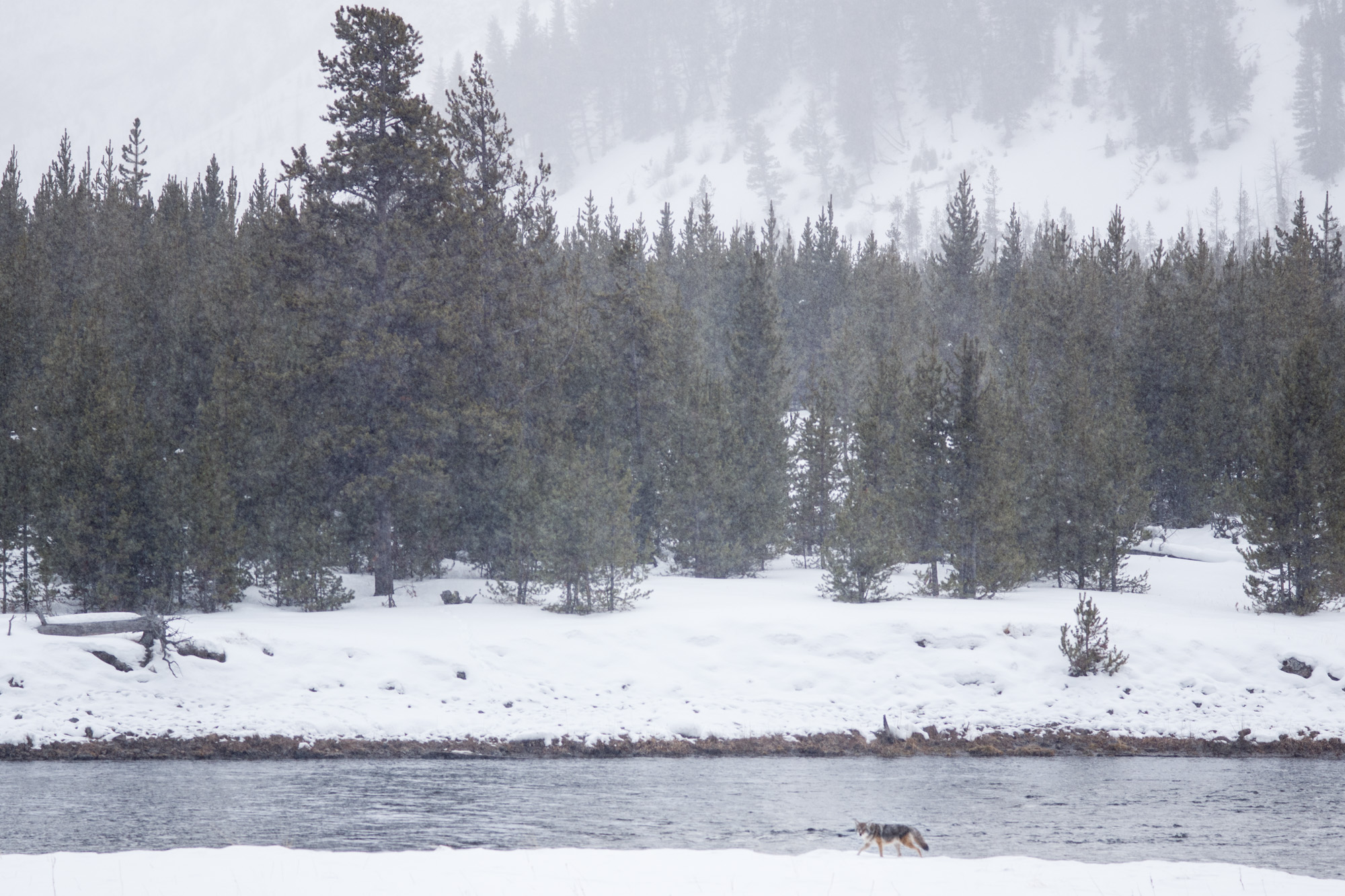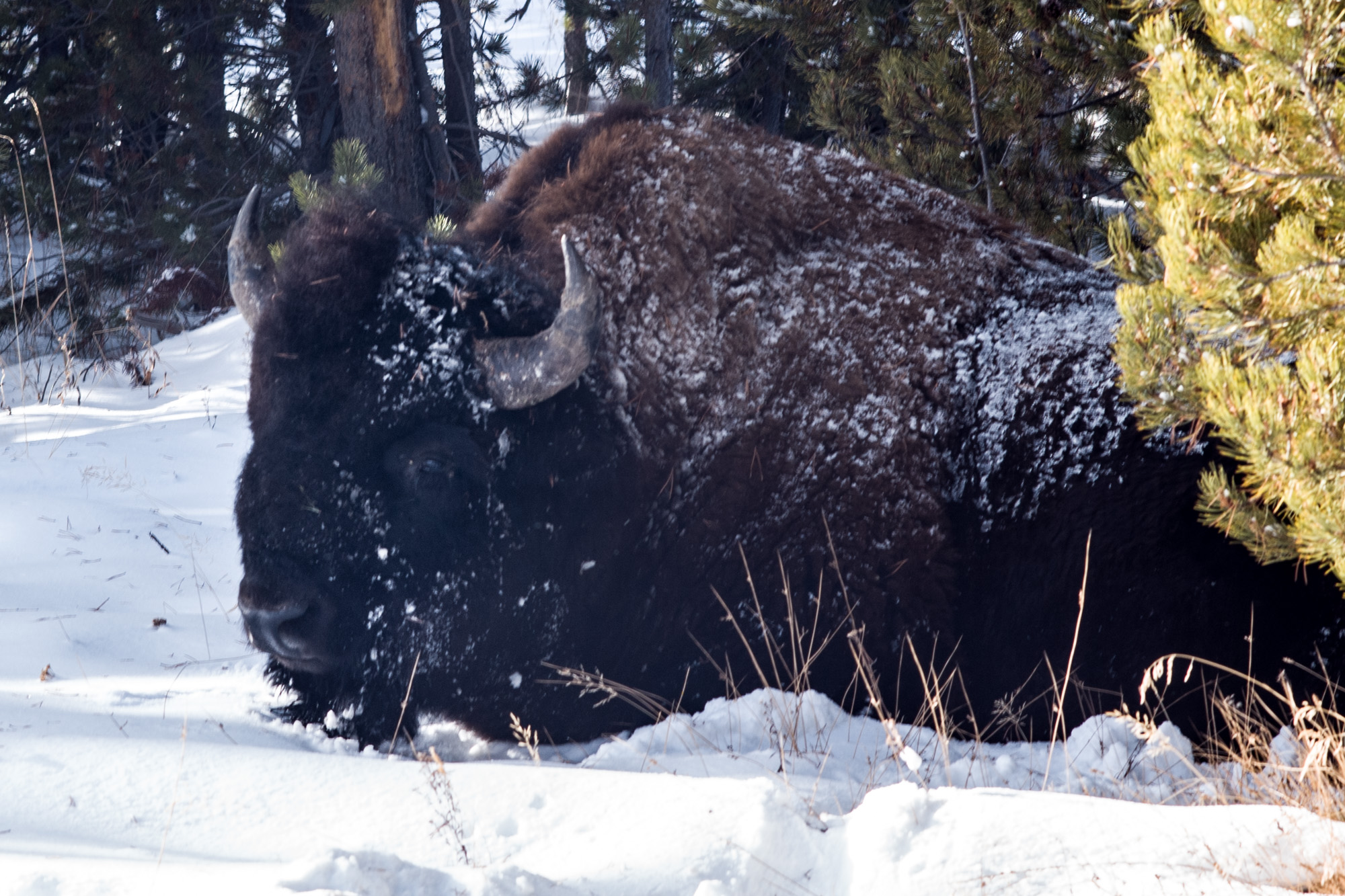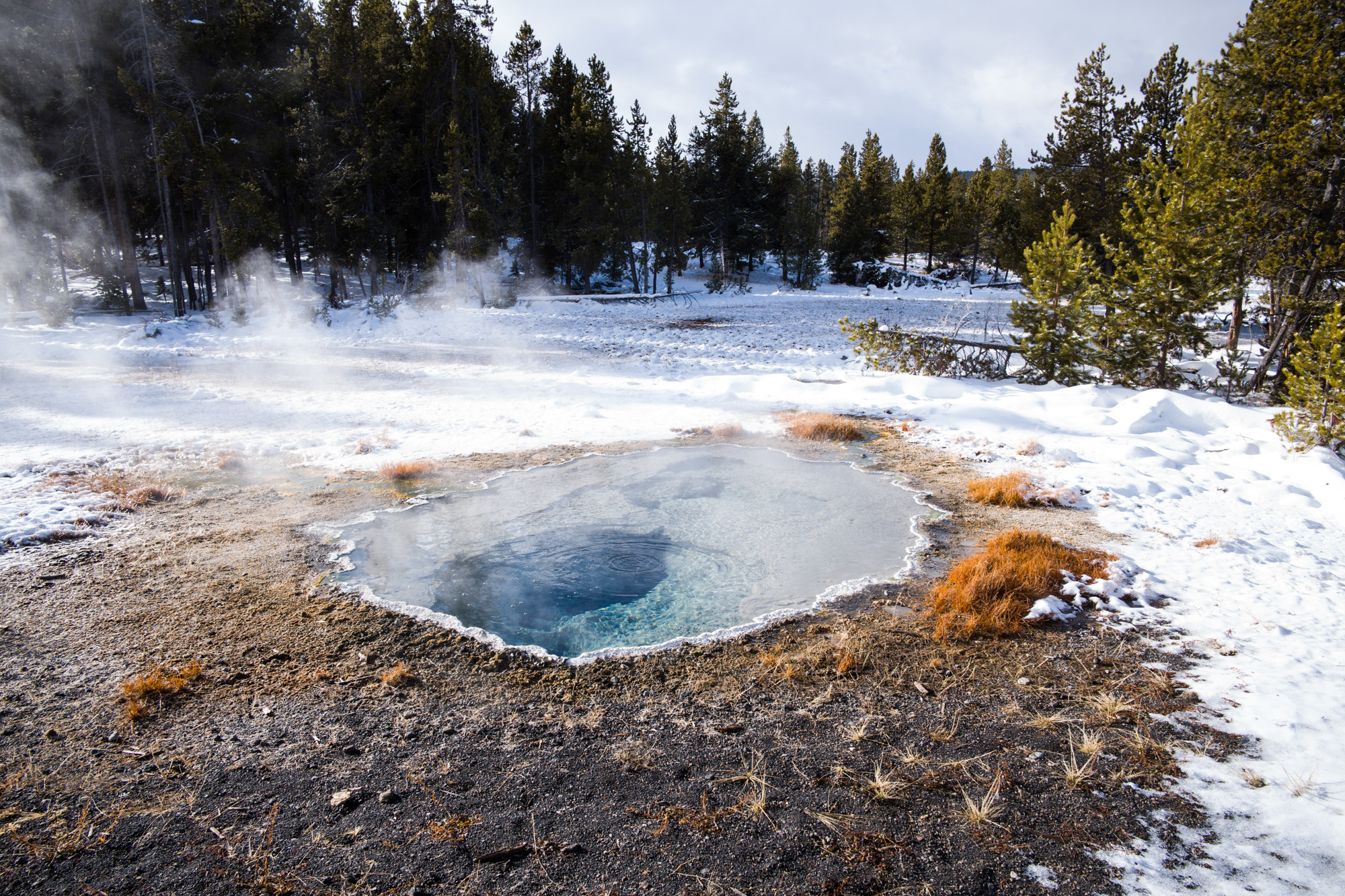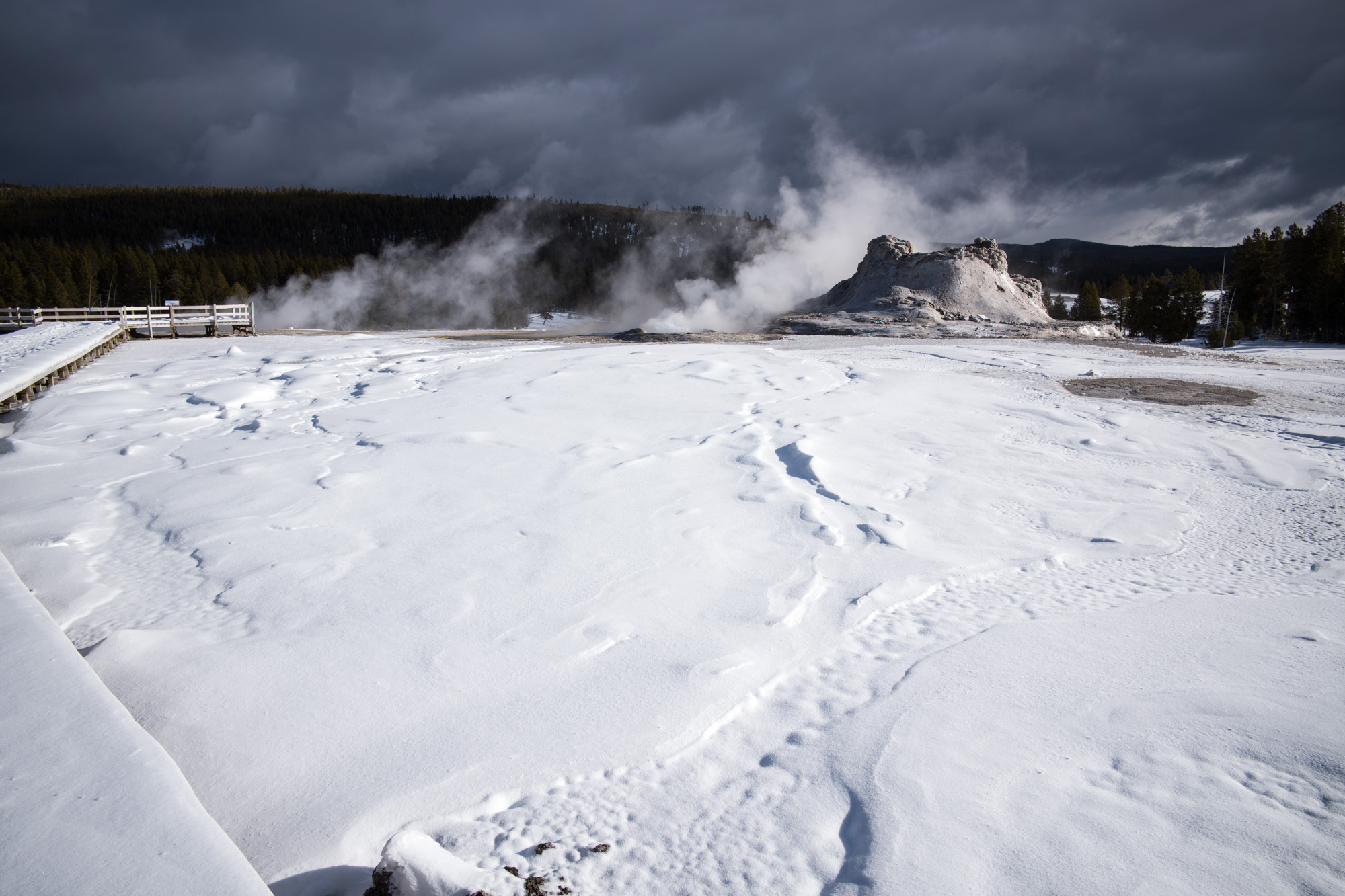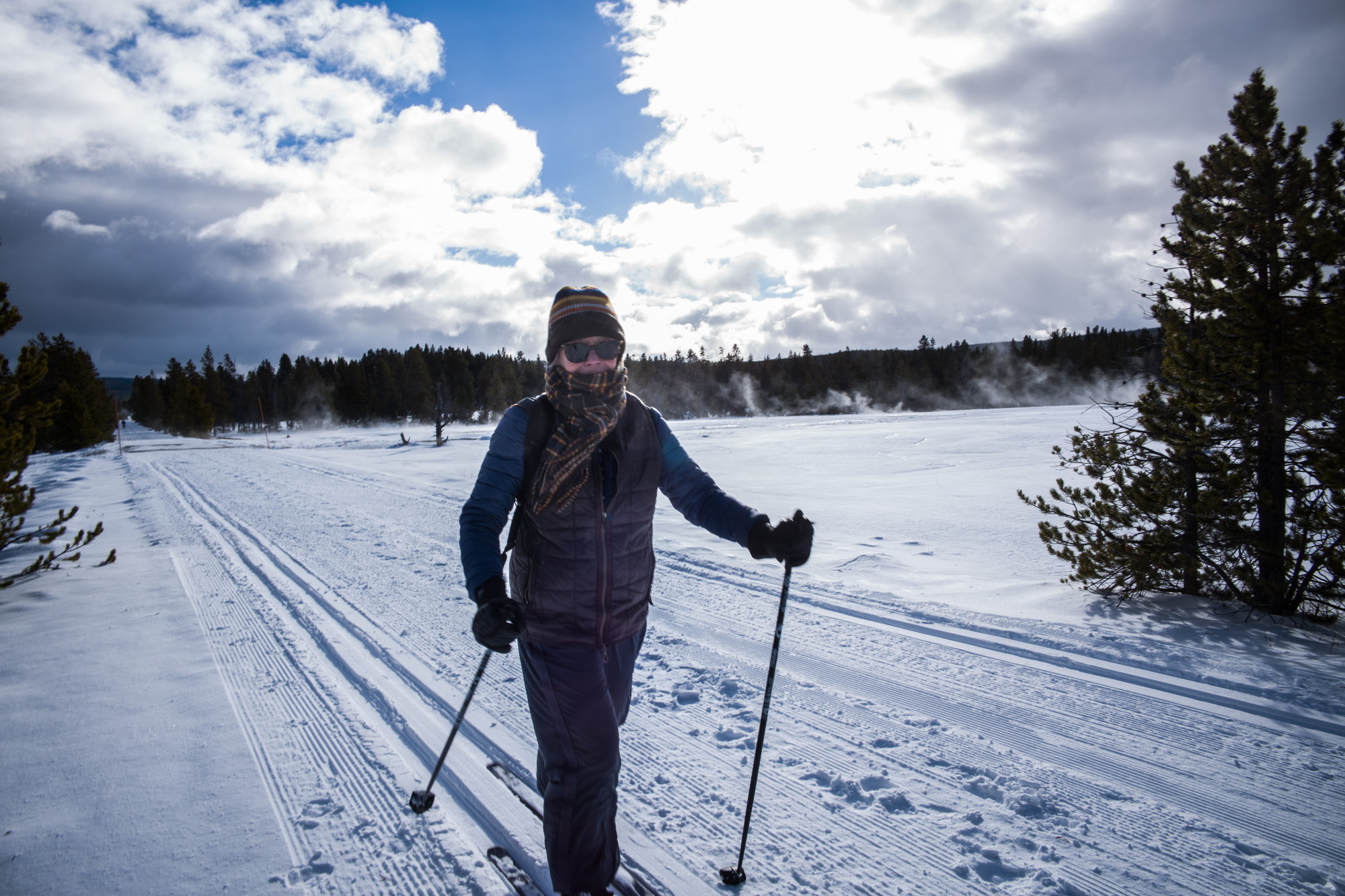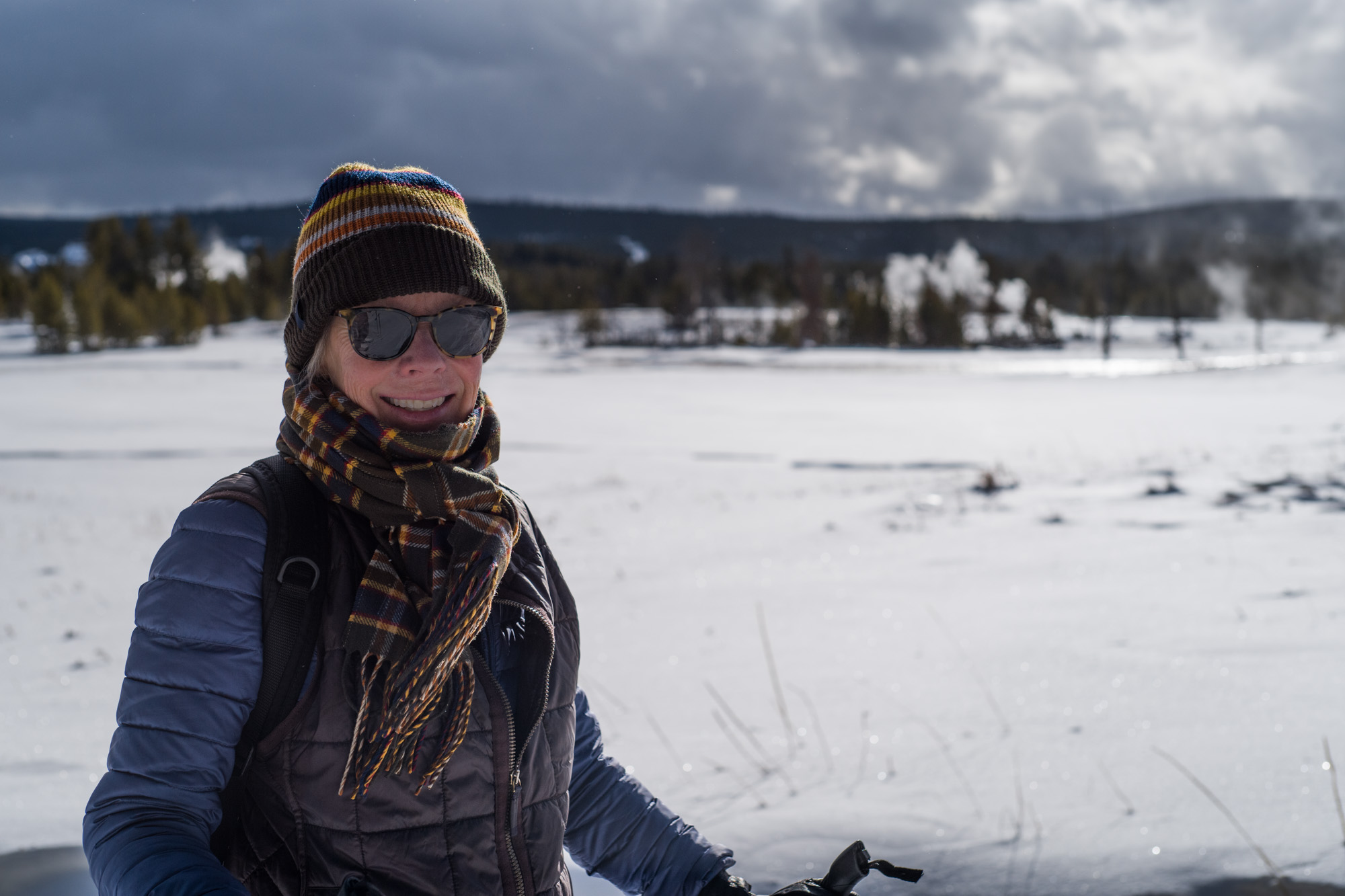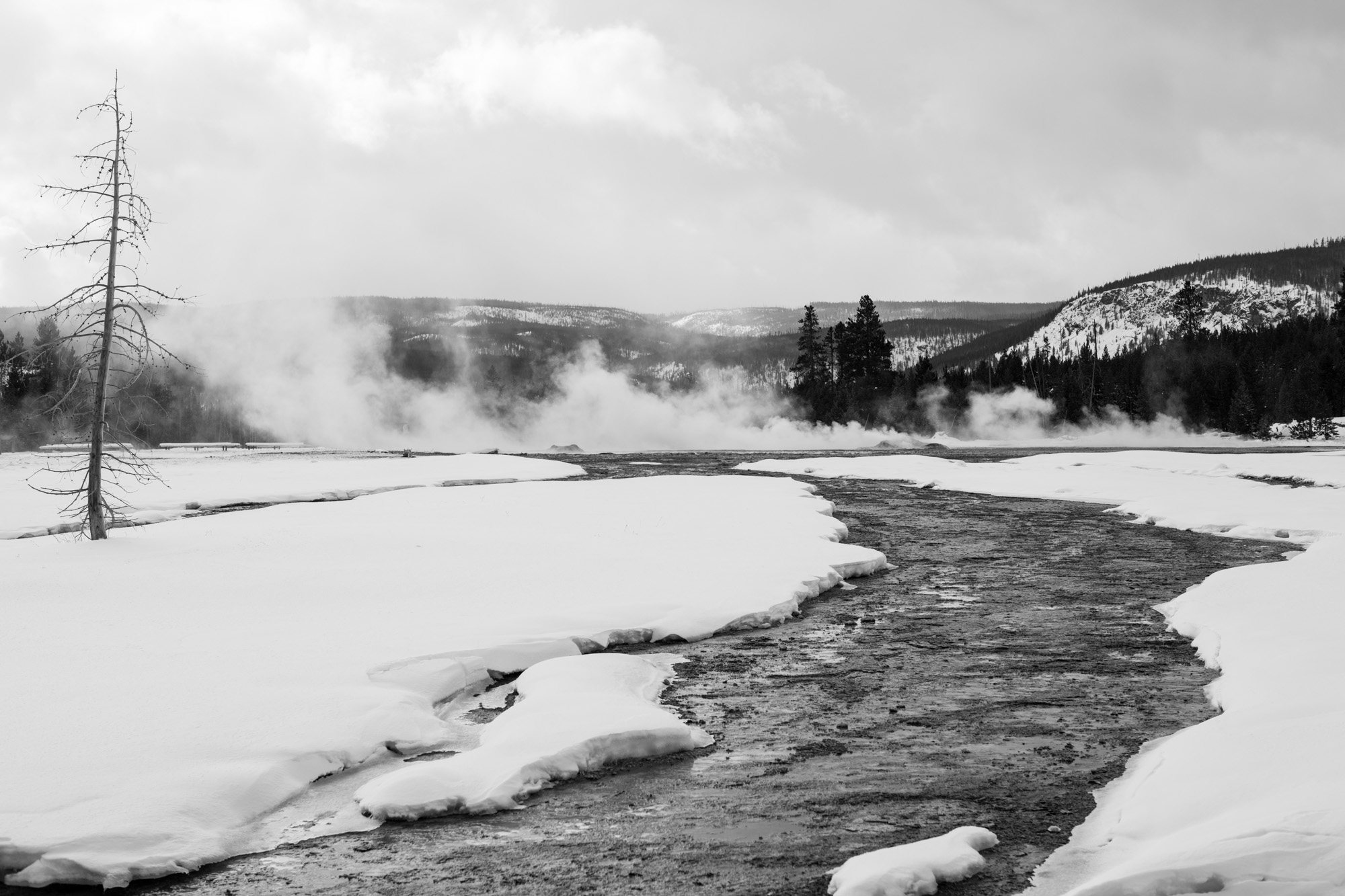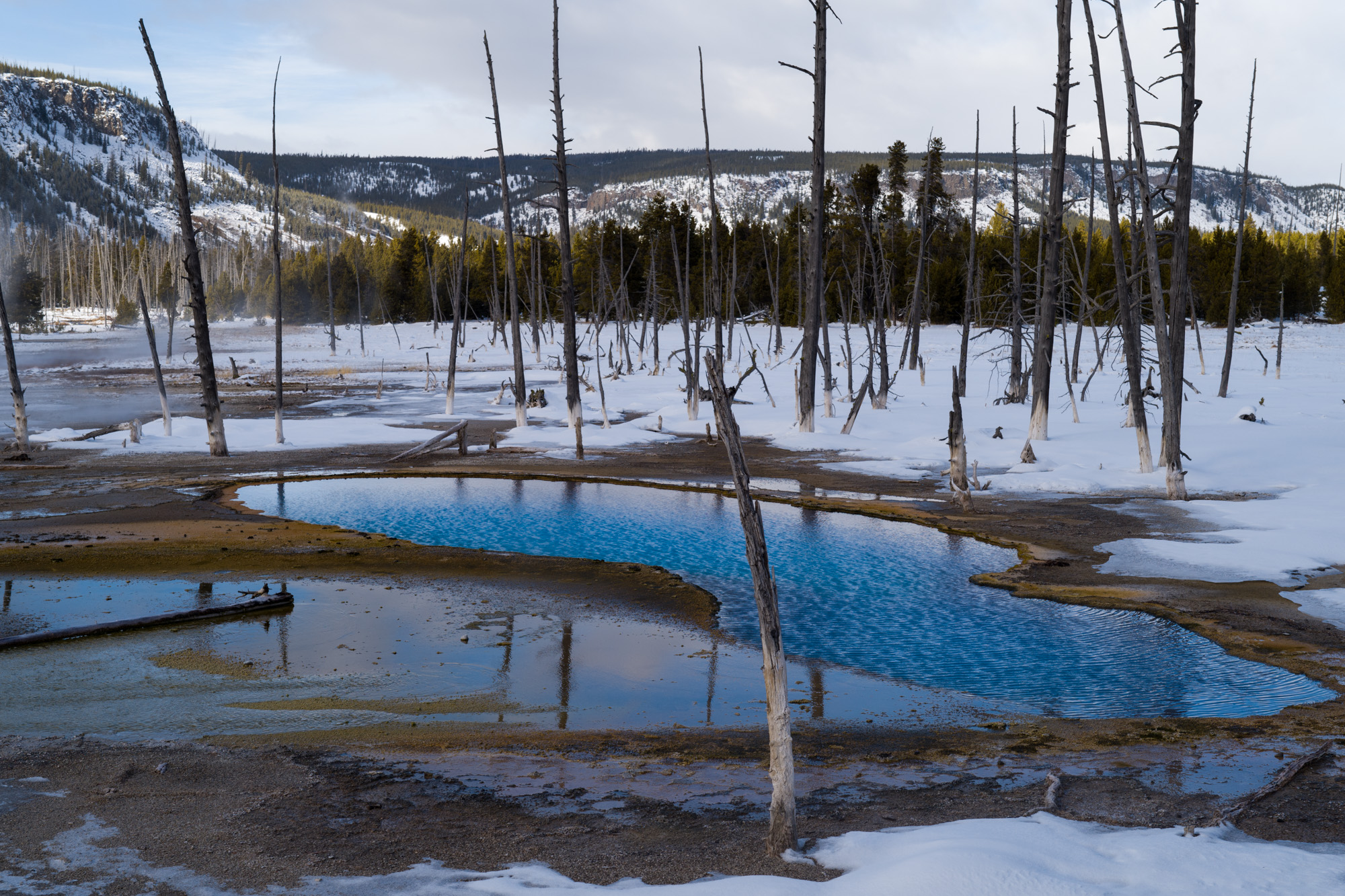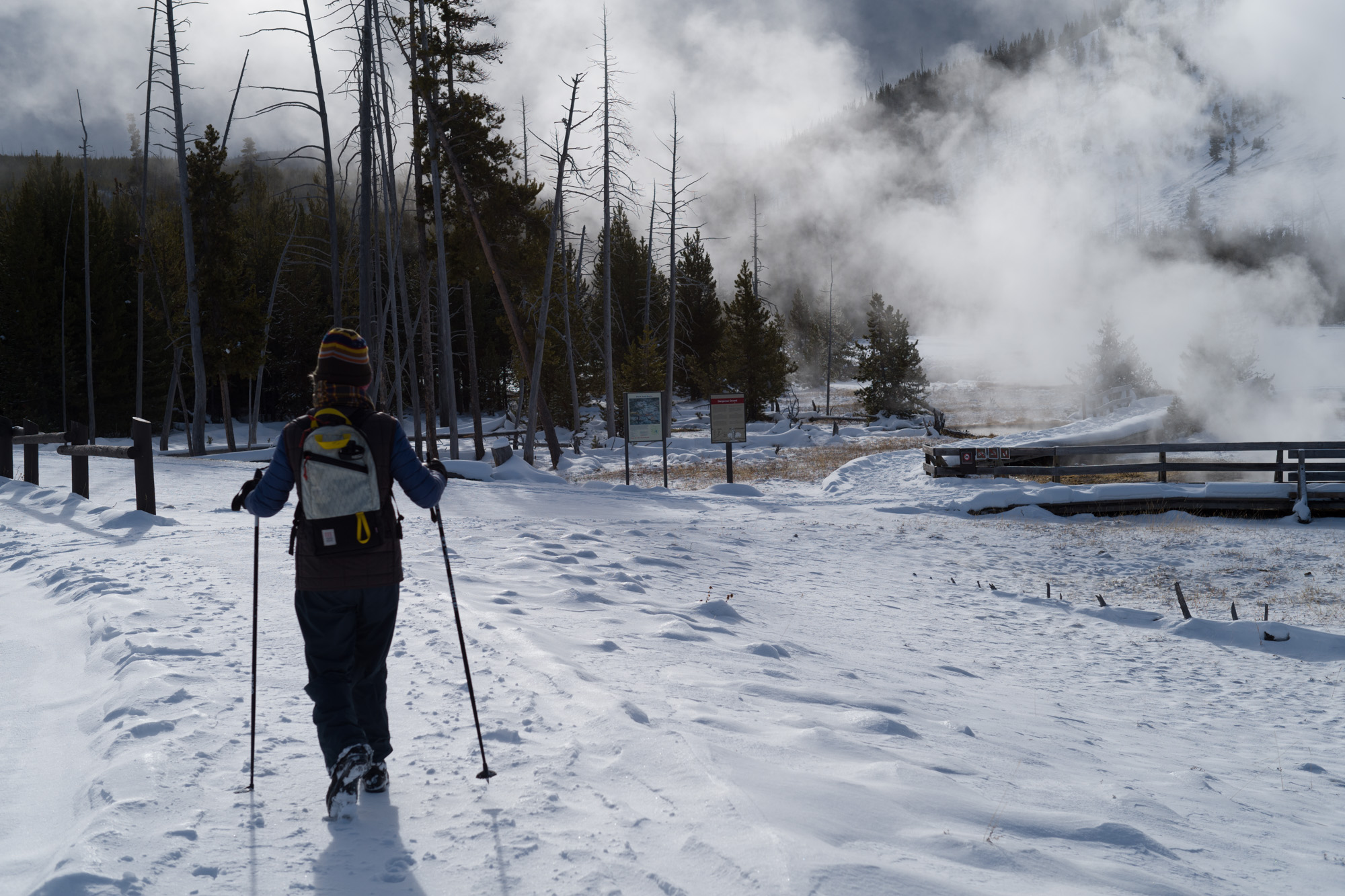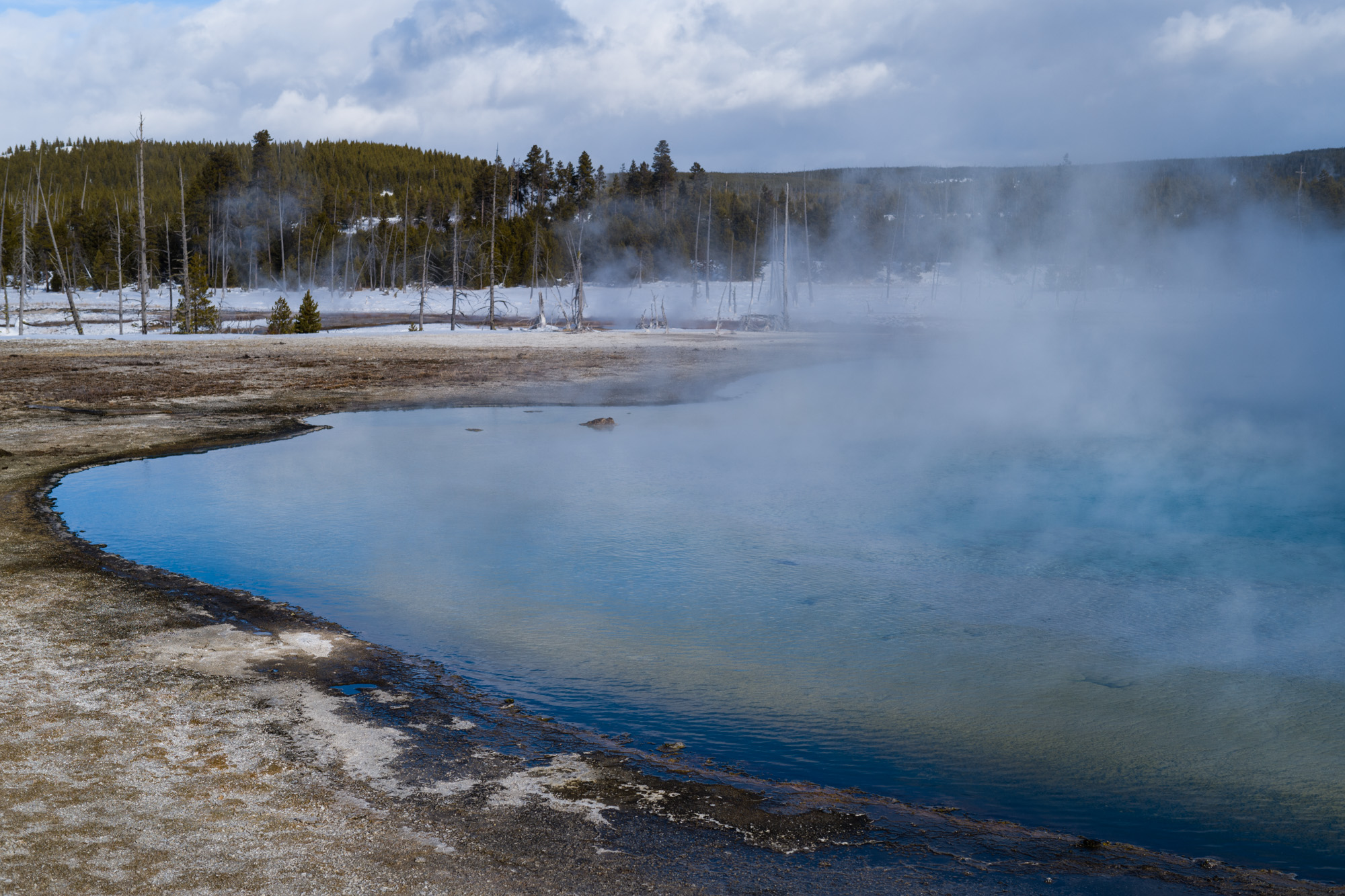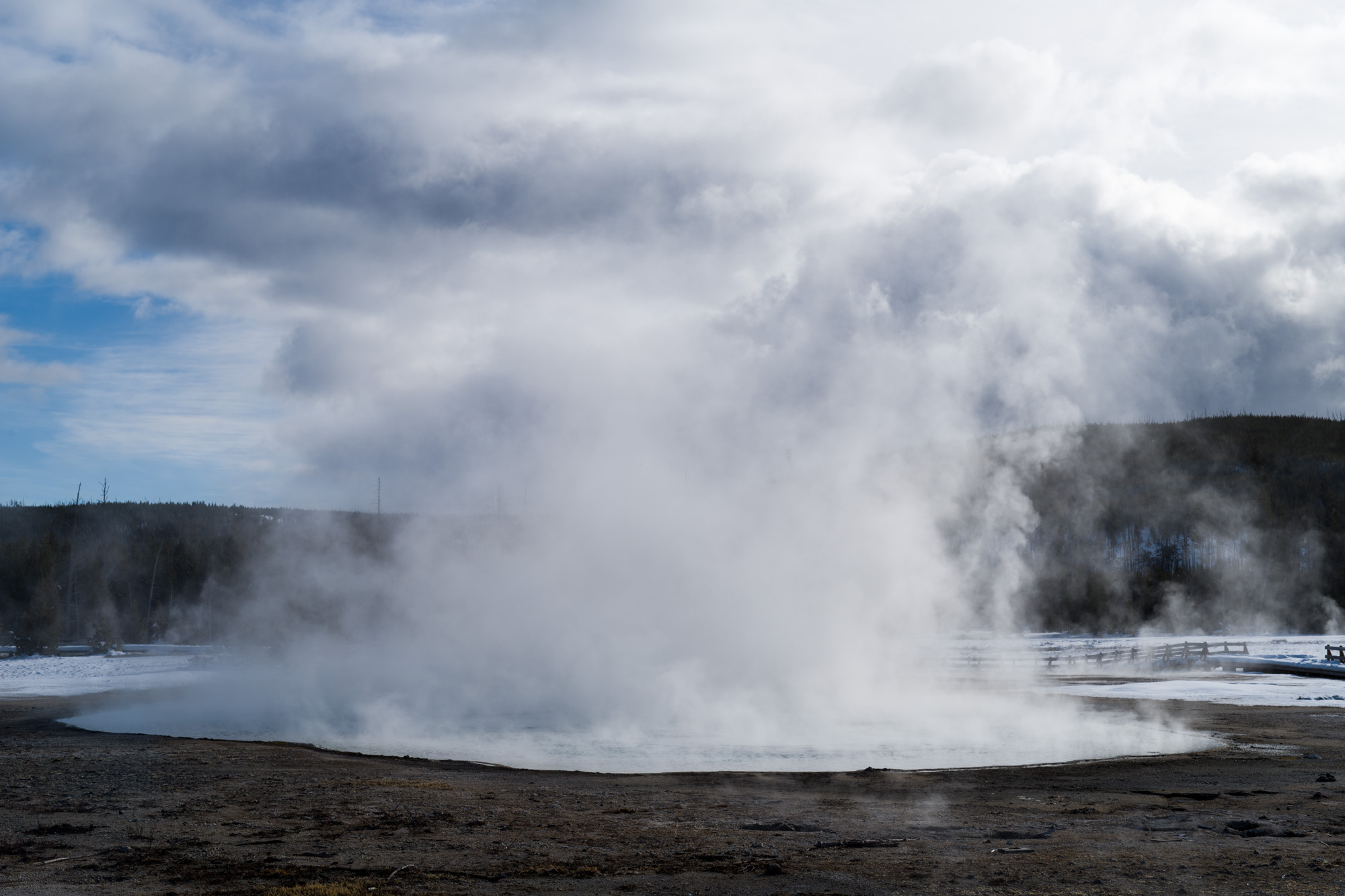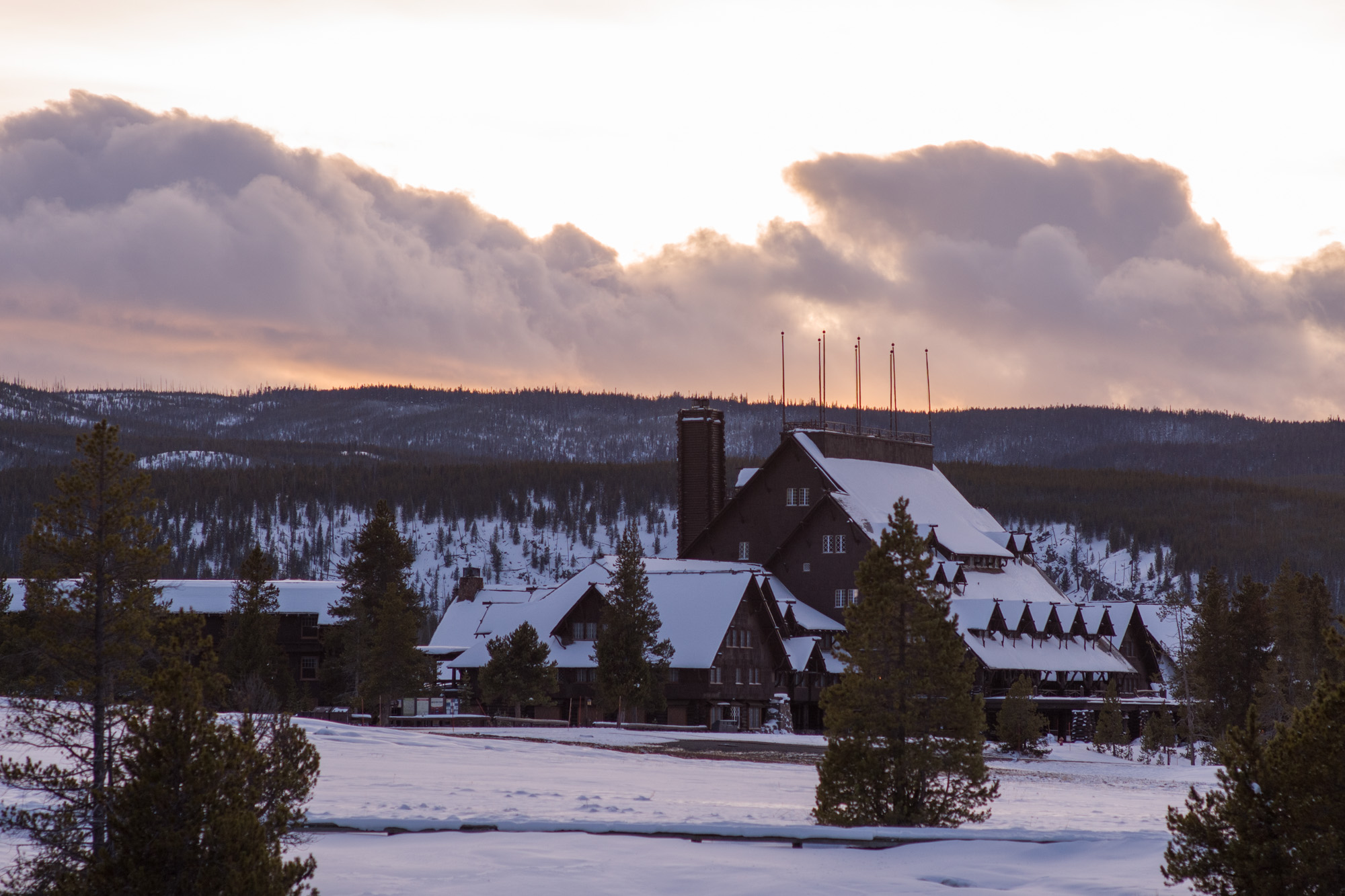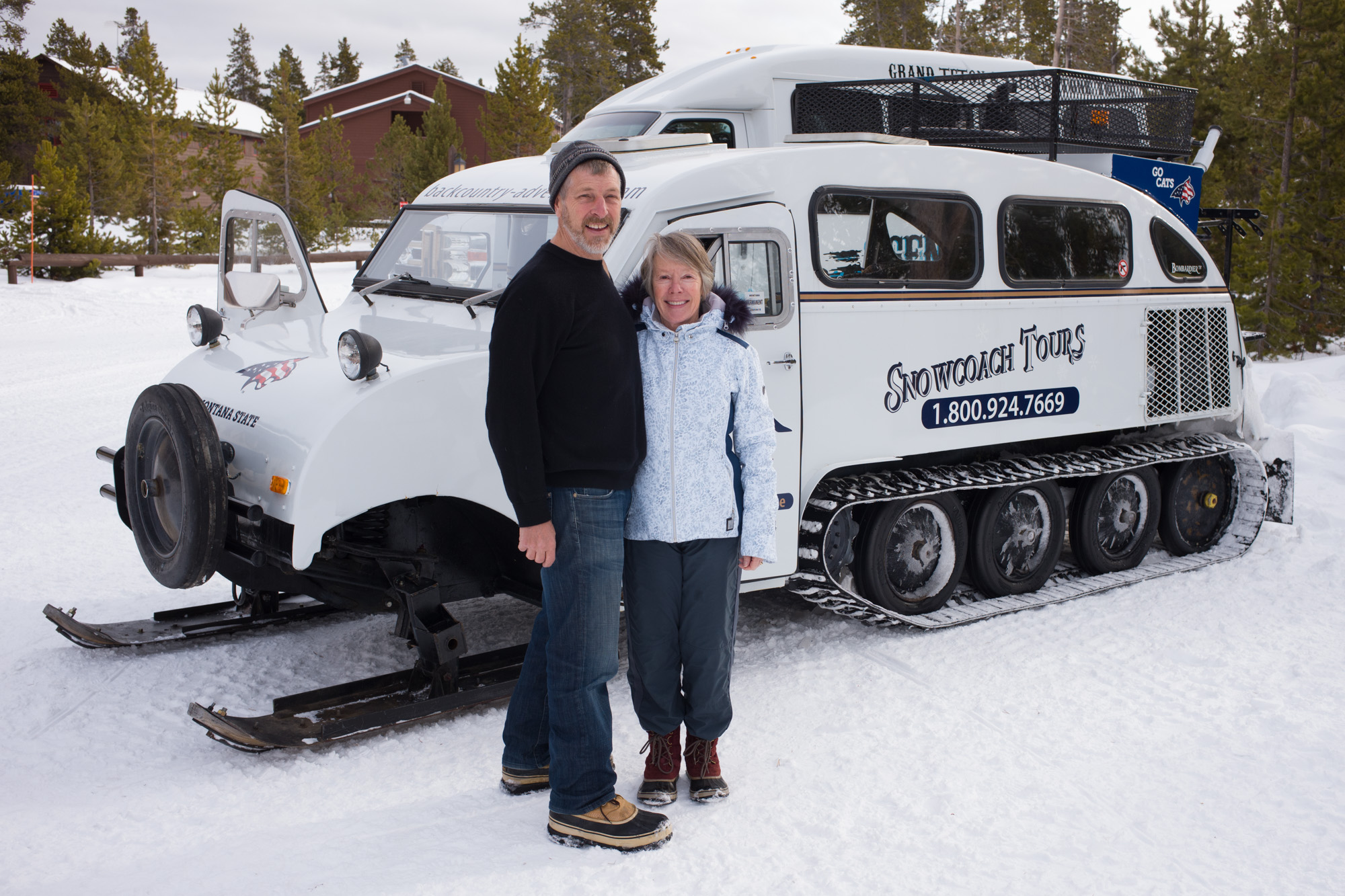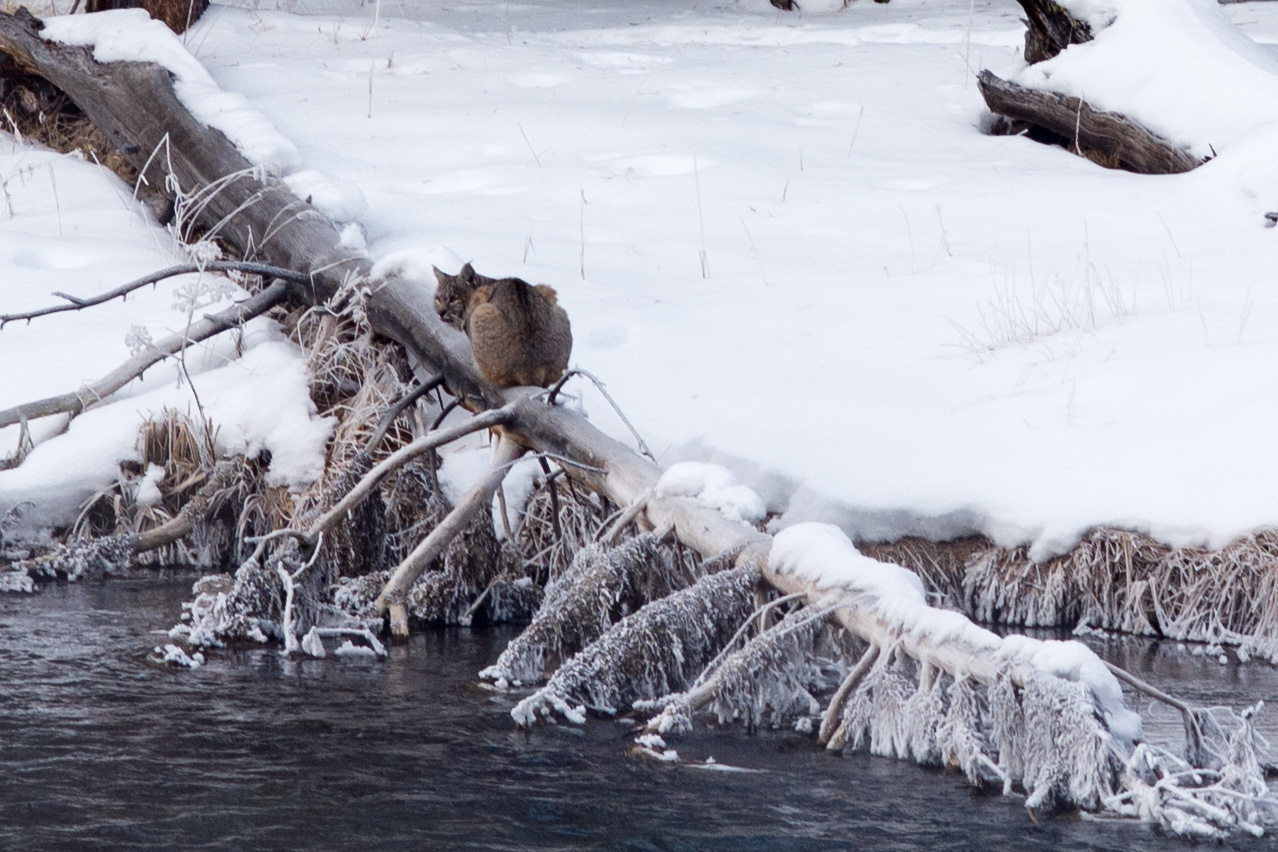Winter Wonderland in Yellowstone
“Everybody needs beauty as well as bread, places to play in and pray in, where nature may heal and give strength to body and soul.”
Volcanic steam creates a magical quality in winter
Update and Reader Suggestions
Staying at Mammoth Hot Springs and Cabins is usually a winter lodging option but not this year due to renovation. It will re-open for the 2019-2020 winter season (maybe earlier) and is a logical place to stay if you utilize the North Entrance of the Park.
Even though there are a variety of entrances to the park don’t assume they are always open (especially in winter) and check with the park service when planning your trip. A prudent move is to re-confirm your plans a week or so before your arrival. Weather and road blockage (rock slides, avalanche, etc) are 2 reasons why a particular entrance may close. Each entrance offers different challenges and opportunities so choose the one best for you. Several readers suggested flying or driving in and out of Bozeman, Montana.
Staying outside the park is also an option. However, shuttling in and out each day most likely during daylight hours will limit your park experience. (Kind of like the experience of staying in Venice overnight is vastly different than day trips.)
We also visited the park after peak season and you can read about our fantastic adventure Wolf Tracking. We have no experience about visiting the park in the summer since visiting in peak season is not our style but the park service offers plenty of information.
Entering Wonderland
From the 1880’s until 1916 thousands of visitors boarded the Northern Pacific Railroad and rolled to the Yellowstone Park entrances. From there they journeyed by stagecoach to the edge of civilization. Yellowstone National Park or “Wonderland” as it was called a hundred years ago, was a popular tourist destination for many city dwellers on the East coast. Today, the stagecoaches are long gone but getting there in winter still takes time and effort. From roughly December through early March, Yellowstone is closed to private automobiles. To visit you enter by snow coach, snow bus or snow mobile. The Old Faithful Snow Lodge is the only lodging available. We booked our ride with Back Country Adventure in West Yellowstone which is run by Jerry Johnson and son, Keith. Jerry is also the former mayor of West Yellowstone for about 15 terms so he knows everything about the area. They also run guided snowmobile tours into the park. Give them a call at 800-924-7669 or send an email to reservations@backcountry-adventures.com. Tip - If you happen to forget (we forgot our winter boots!) or don’t have heavy duty winter gear, you can rent warm snow suits and Sorel snow boots from Jerry.
Snow coach and boots courtesy of Backcountry Adventure
The lovingly restored 1930 snow coach was warm and cozy inside. Our driver, Mike Swanson fired up the motor and our adventure into Wonderland began. From the West entrance the trip takes about 2 hours. If you enter through the North entrance plan on doubling the drive time. Swaney makes the trip fly by with stories about park history, wildlife and present day challenges. Beautiful landscape came into view as we gazed out the windows. And since few people visit in winter, the wildlife have no need to hide.
Bison herd grazing by a thermal pool
The speed limit is 25 mph and outfitters who earn and pay for the right to shuttle guests lose their permit if they speed. Strict rules apply for extended, unplanned stops along the way, however, slowing way down, appeared to be within the rules. Of course, if any animals (like bison) are on the road, they get the right of way.
The landscape, other than the thermal pools and land surrounding them, is blanketed in white snow. Within minutes, we saw trumpeter swans, the heaviest living bird native in North America, cruising the Firehole River with their teenage cygnets. They appeared content in the near freezing water and took no notice of us. A mile down the road, a solitary bull bison took his sweet time ambling along the road. We also saw a bison nursing herd heading toward thermal pools hoping to graze on patches of green grass.
Swaney is a “year rounder” which means he lives here full-time and knows the best places along the route to spot wild life. He told us to get ready for a “polaroid moment”and look at the large fallen log on the far river bank. He eased off the accelerator and we had time to take a quick photo of an intensely focused bobcat (the size of a mountain lion!) who was perched and ready to pounce. Once Swaney put his foot back on the gas pedal the cat quickly moved into the woods.
Yellowstone has Teeth
Swaney’s Bobcat
In winter the park animals survive by eating enough food, staying warm and avoid being eaten. Even though the first snowfall of the year fell in September, winter doesn’t really arrive until January or February when temperatures range from 0 to 20F (-20C to -5C). Sub-zero temperatures are common at night and at higher elevations. The record low temperature is -66F (-54C). Snowfall is highly variable but the average is 150 inches a year. It is not uncommon for higher elevations to get twice that amount!
A coyote hunting for lunch
As our snow coach rolled down the white road, Swaney always waved and gave the “thumbs up” sign indicating that all was well whenever we encountered other people. The “ok” gesture is a part of life here because winters are hard in Yellowstone. Getting stranded on the road for a few hours could easily turn into more than an inconvenience if other helpful people aren’t around.
in 1980, another year rounder, Marjane Ambler wrote in Yellowstone Has Teeth that the park ”could be an unforgiving place where mistakes mattered. She shared a hidden Yellowstone, a place where delight and danger are separated by the slimmest of margins: a degree of pitch on an avalanche slope, a few inches of a buffalo’s horn, a moment during a deadly wildfire…The rangers and maintenance workers who handled everything from thundering avalanches to man-eating grizzly bears. The mothers who carried their babies inside their snowmobile suits and prayed their machines would not fail on the long ride home. The old-timers who forged communities despite the odds against them.”
As we got closer to the Lodge, Swaney explained that the 25 mph speed limit applies to everyone including emergency vehicles. He advised us to stay on the pathways, stay warm and not get hurt. Emergency helicopter service is available but is expensive!
The Old Faithful Snow Lodge
Old Faithful is different in the winter
The Old Faithful Snow Lodge is adjacent to the iconic Old Faithful Geyser. The lodge is comfortable with modern amenities like comfy chairs in front of a grand fireplace, private baths, hearty meals and slow internet service. There is only one dining room open for meals. Tip- Make dinner reservations when you book hotel reservations! There is live music at night and a comfortable lounge to enjoy adult beverages. A roaring fire fills the fireplace in the grand entry room. Borrow a book from the lodge’s loaner library. There are no TVs.
Next to the lounge is a long room with windows covering the entire wall. It is a comfortable place to enjoy the beauty of Yellowstone while making plans or conversing with friends about the adventures of the day.
A small store in the lodge sells all the items you forgot to bring as well as souvenirs to bring home. You can also rent snow shoes or xc skis or sign up for a tour or go out on your own. You can hike, snowshoe or xc ski to the thermal fields on your own. There are no crowds since visitors and staff are the only people. Winter is a far cry from the crowds of summer.
Things to Do
Rent Snowshoes or xc skis. Professional guides will cheerfully point out trails to go on your own or join a group tour. Walking through the geyser field is a must. If you hike up to the Old Faithful Observation point, snowshoes make the journey much easier than wearing boots.
Explore the Old Faithful Visitor Center at a relaxed pace. With no crowds the rangers are available to share their wisdom.
Book a Tour. The Lodge offers many tours to explore the park. Wildlife tours, cross country ski tours, photography tours, snowshoe walk abouts and snowmobile mobile excursions through the Grand Canyon, Stars and Steam… Check out the full offering here.
Photography with Lisa
Photographers and the Yellow Snowcoach
Lisa Culpepper offers photography tours in winter (and Alaska in summer). As Ansel Adams said, “A good photograph is knowing where to stand” and Lisa knows the right places to stand in this vast park. Lisa knows where to find coyotes, bison, swans and even bobcats. She knows how to capture steam and ice in the same shot.
The trip included a box lunch and a comfortable window seat in a warm snow bus so everyone gets a great view. Lisa accommodated our diverse group with ease. She helped the novices set white balance and exposure compensation in order to get pleasing images in a snow filled winter scene. Lisa is also very knowledgable about the history of the park, sharing stories as we drove through the snow. Her tour was fantastic.
Tip- Sign up early to assure yourself a spot because her tours sell out.
Opalescent Pool in the Black Sand Basin
The Trees are Story Tellers
Gregor, our Snowshoe Guide
A tree tells the story of bison polishing their horns
A 2 hour snowshoe group trek is an excellent way to experience the majesty of the park. Our multi-generational group learned how wildlife and humans have co-existed for thousands of years in this harsh and magical land. Gregor, our enthusiastic and knowledgeable guide, leads snowshoe and cross country excursions. Along the route, he shared several of the park’s myths and legends. He explained how “the trees tell stories if you take the time to look.” Rubbed off tree bark reveals the presence of bison or elk since they polish their horns/antlers on the trees. He pointed out a tree with rather large claw marks because a bear decided climb up. Other trees with water marks indicate flooding from previous years. Groups of dead trees reveal either previous thermal activity or perhaps fire. Each year the park experiences 10 to 30 lightning fires which keep the ground clear of dead wood. The Yellowstone Fires of 1988 were instrumental in the public’s understanding of the role of fire in ecosystems, history-making, and career-building. Over 17,000 acres burned and the flames were perilously close to the park’s largest camp ground.
Wildlife
Bison in the geyser field
While Yellowstone is renowned for wildlife, the animals are more visible in the solitude of winter. We came pretty close to a bull bison at the Madison thermal area. He was hidden on the other side of a small hill but made his presence known by lifting his head. The warmth of the geyser field melts the snow and exposes the grass which creates a picnic stop for bisons.
Another highlight was following a coyote down the Madison River as he hunted for lunch. Searching the snow for signs of life, he suddenly pounced to catch a mouse hidden beneath. He also attempted to snatch a Blue Heron but the bird was too quick.
Back to Civilization
We met Swaney in the Lodge’s grand room, loaded our bags in the snow coach and headed back to West Yellowstone. On the way, he pointed out an enormous bald eagle perched on a lone tree top overlooking the Firehole River. Apparently, this bird has made Yellowstone his winter home for over 20 years.
Our Yellowstone adventure was 4 days of action packed adventure. If you love the outdoors in winter, please consider a visit to Wonderland in Winter!
Images of Yellowstone in Winter
